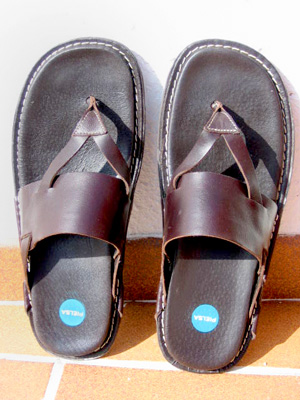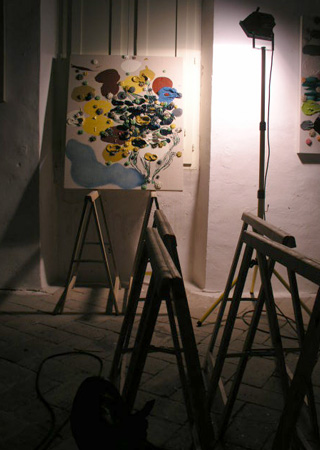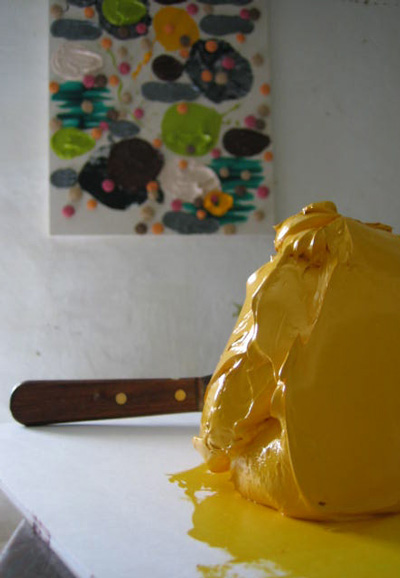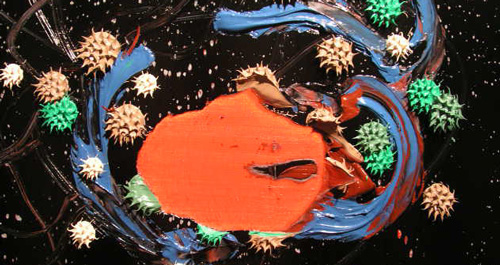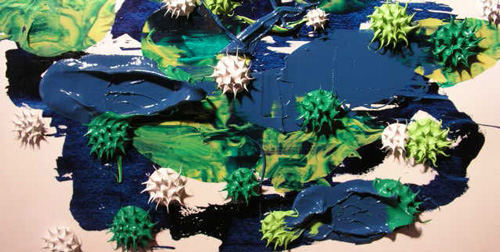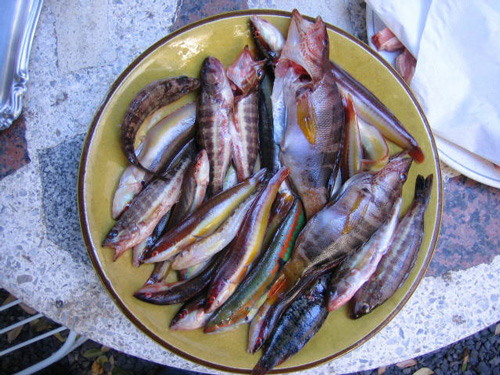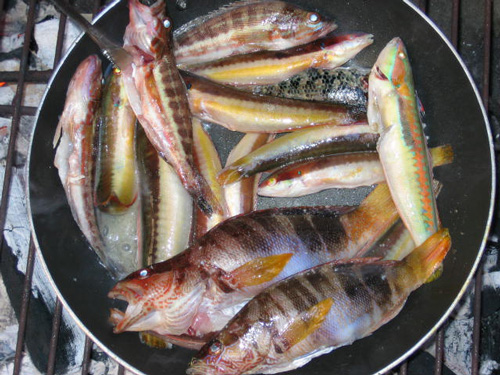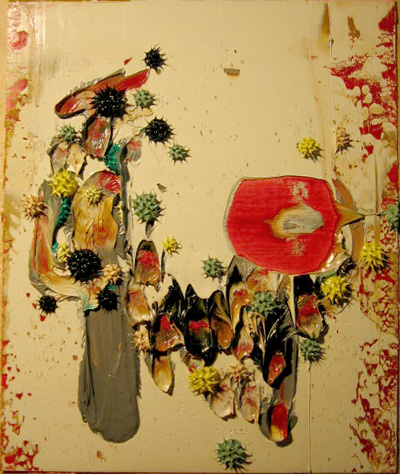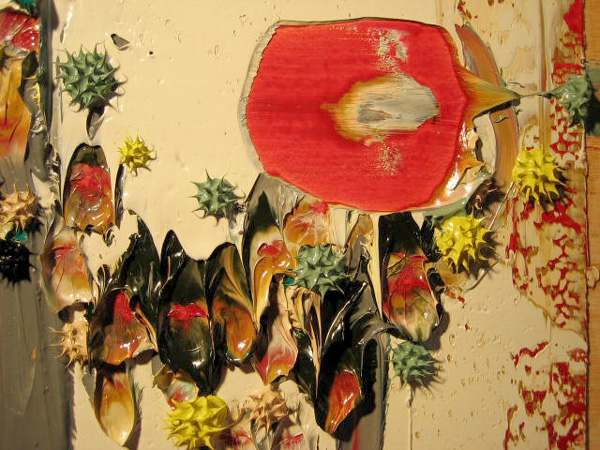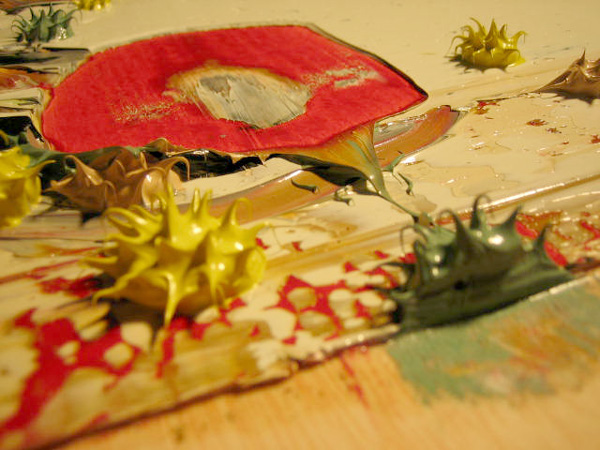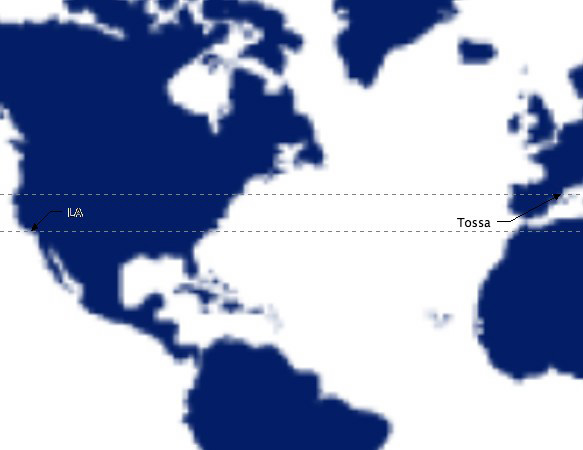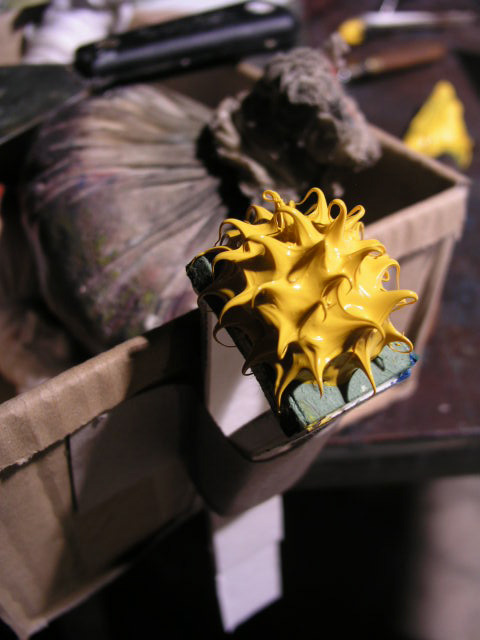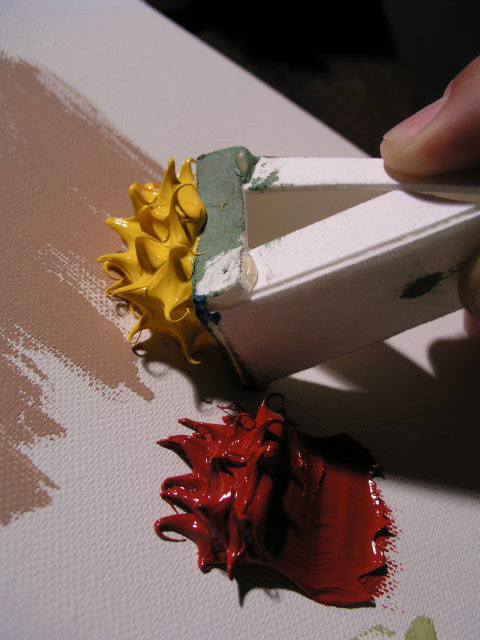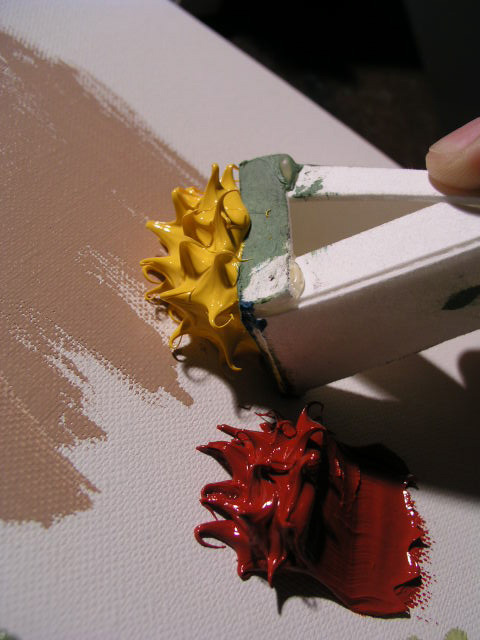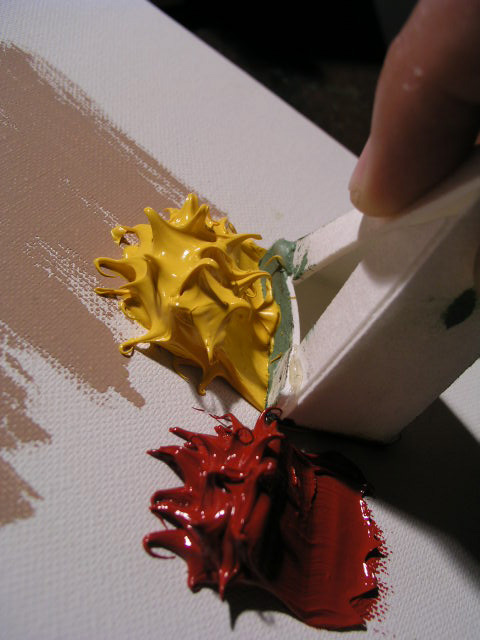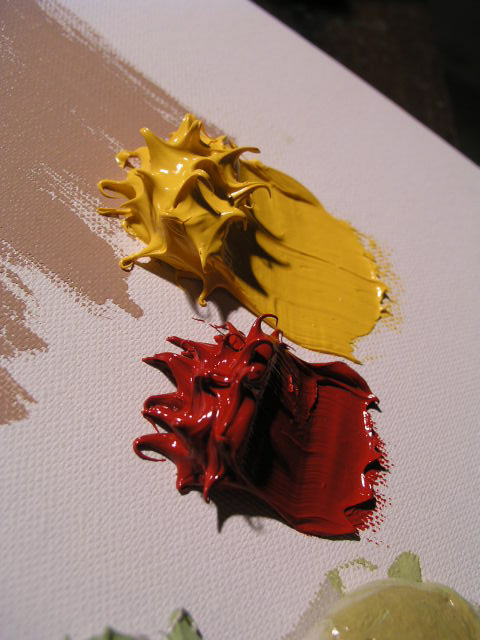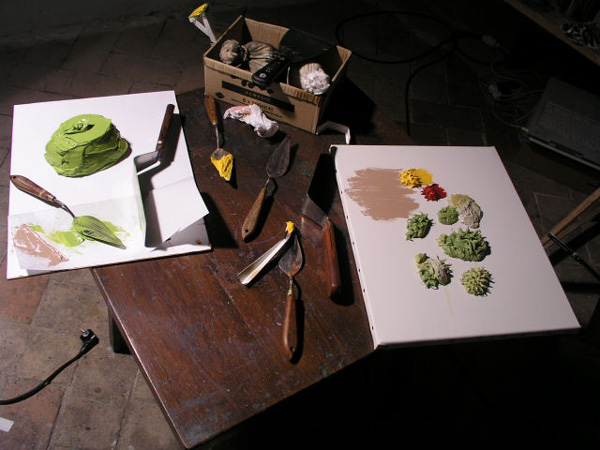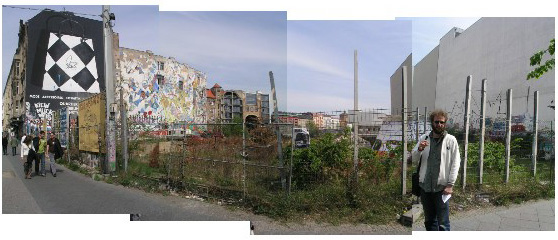May 31, 2005
Last Weekend
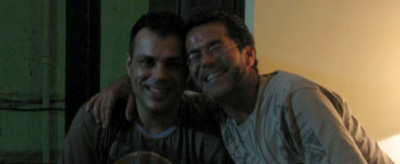
It was in the wee hours of the morning that Kiko saw that I had my camera out. He pulled up next to Joan and said to him: "Watch, you will be on the web now!"
So be it.
(Joan and Monica own the restaurant "Es Congre" and Bar San Antoni here in Tossa.)
Here were the order of events for last Saturday, a slice of Tossa life:

-Lunch in a country restaurant with Ramon and his family: wife Asumpta, daughters Alba and Estelle and Estelle's boyfriend Nacho.
-Siesta time 'cause I know how long the night will last.
-Met Kiko at Bar Josep, cortado and water
-Dinner at Can soms (whiich has another name) cod in garlic sauce and butttifara in string beans, muy bien.
-whisky at Bar Savoy, hooked up with Ramon (rare to see him about), who was going to the wedding party
-after the drink, we went with Ramon to Can Barraca, a wedding party, (a lawyer from Barcelona)
-rendezvous at Nacho and Leslie's place, drinks, meet Xerlo and Maite.
-San Antoni with huge Knocandos.. I sip and sip yackity yack, wiggle to "Just a Gigolo"
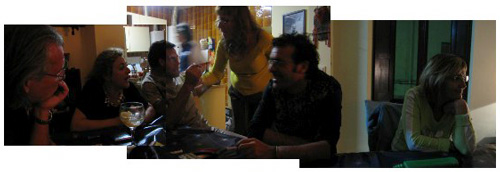
-Nacho and Leslie's place, a CocaCola and I got my ears chewed off by the woman who owns a corner shop and had that kickin' party we saw last summer on the terrace near the castle.
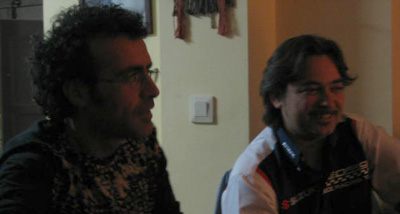
-Bed by five
EU Born
The most wildly breaking news is the rolling votes for the EU constitutional referendum. Tommorrow, the Netherlands will conduct their own vote, fresh after yesterdays' French "non". The ramifications for this are hard to estimate with some saying no big deal to others predicting the worst.
Consider this interesting article from the Times Online.UK convincingly portrays a face off between Chirac and Blair:
TONY BLAIR is preparing to battle with President Chirac of France over Europe?s political direction for the coming decades.Note: "Liberalism" in the EU means free(er) markets... (towards capitalism).The chaos in Brussels caused by France?s unexpectedly emphatic rejection of the European constitution has put Mr Blair, who takes up the EU presidency in July, in a powerful position to impose his vision of the future shape of the Union.
...The Prime Minister called for a ?time of reflection?, and said that French voters ? many of whom want more social protection from Europe ? had raised serious questions about the future of the EU.
Taking a break from his Italian holiday, he said: ?The question that is being debated by the people of Europe is how do you, in this era of globalisation, make our economies strong and competitive?? The political vacuum has prompted a battle for the ?heart of the Union?, with Mr Blair keen to push more liberal economic policies, rather than French-style social protection with a large welfare state.
...Marco Incerti, of the Centre for European Policy Studies, which is funded by the Euro-pean Commission, said: ?There will be a fight for the heart of Europe.?
President Chirac is expected to push hard to reassert his political authority. Sources close to the French President have given warning that he will be ?more difficult, less co-operative and less European-minded than before?. One said: ?The French Government will interpret ?no? as against being European-minded and reasonable on things like the budget.?
Charles Grant, the director of the Centre for European Reform, which is close to Mr Blair, said: ?The British presidency will be a very difficult act to pull off well. France?s ability to be bloody-minded is great.?
EU leaders will try to resolve the crisis at a Brussels summit next month, but if, as expected, they fail, it will fall to the Prime Minister to find a way out of the impasse.
As president, Britain will chair almost all negotiations between EU ministers, with the right to propose and withdraw initiatives, putting it in a powerful position to resolve Europe?s worst crisis for 50 years.
Mr Blair has made economic reform the top priority of his presidency, hoping to make labour markets more flexible in order to tackle record unemployment and sluggish growth across the continent. However, he is now likely to face challenges from President Chirac, who recently called economic ultra-liberalism the ?new communism of our age?.
A few observations:
-The process of inaugurating the EU seems to be a top down affair. I hoped that the creation of the constitution would have been a broad debate, but alas. The EU constitution seems to reflect this in a bloated and unmanageable document that came out of nowhere, a document which paradoxically seems overly concerned with management rather than... vision. It reads like some terrible product of a faculty meeting from hell. One consequence is that a lot of Europeans don't care... at least that is what I thought when we watched the Spanish vote recently.
-Installing the Euro currency system before establishing a constitution is like inserting foundations after building a house. It's pretty tricky but the good news is that it can be done... to houses that is.
-I recall many articles I read when I used to subscribe to Foreign Affairs long ago that dwelt with the need for Europe to reengineer their social system so that it can live and prosper beside the free market economies around the world. Some say that it can't be done, others hesitate to suggest how it can be pulled off. Maybe Blair can do it.
Personally, I wouldn't want Europe to transmogorify itself into the USA economic model. It is not possible anyway. There are deeply held and important fraternal values that need to be preserved, grown, expressed and salvaged. Trouble begins when it becomes a face off between antagonistic aspects. Is this neccessary? There is no need for conflict between systems that should instead be complimentary. After all, underneath this polarity lies a foundational conception about human freedom... no?
?No?
In Memory Of
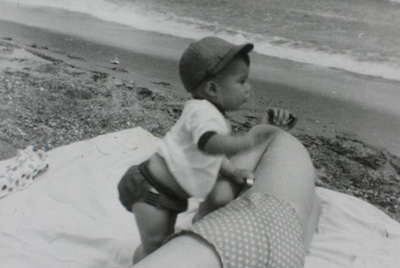
One time my father told me that he felt that the Korean War was a mistake, that it was not worth it. He was one of the first troops inserted into the Pusan Perimeter to stem the Communist advance across the whole peninsula. It is an immense story, one that I think is neglected. And there is no way that I can do the telling of it any justice in this brief blogpost. It deserves more than that.
(Prepare -if you will- for short, brutal strokes:)
It was five years after the second war after the war to end all wars. America's military was unprepared, neglected... people didn't want to think about war any more. As a result, young and inexperienced troops were thrown into hell with little equipment or preparation. My dad had just turned eighteen years old.
My father survived, and for the fifty years after his unit was wiped out, he built a wall against it in his mind. He rarely spoke of his time there as I was growing up and when he did it was clipped. Fifty years later, the wall fell apart and he succumbed to PTSD... he went mad. Uncontrollable flashbacks. Shock therapy, medication. The medical benefits were insufficient, a symptom of national neglect. Unable to maintain the distinction between reality and imagination (the war), he finally took his own life almost fifty years to the day when his unit was surrounded by the North Korean army and wiped out. He was among a hand full that managed to escape in a melee of hand to hand, eye to eye desperate man killing battle.
I write this remembering that our society (my experience in the USA at least) has for generations satirized a stereotype of the crazed veteran. Hollywood has amused millions and made money off of the cartoon image of the mentally destroyed, pathetic ex-soldier.
What a shame.
What a shame.
Here, a small peep from whatever fragments the Army's historical record can provide:
Page 224 SOUTH TO THE NAKTONG, NORTH TO THE YALUMy father's brief account portrays the eighteen men who forded the river as the only survivors. They made their way back through hostile country, escape and evasion.Meanwhile at Anui, Lieutenant Hughes' B Company, 28th Infantry, was under attack from superior numbers closing in from three sides, and by nightfall it had been forced back into the town. Hughes made plans to withdraw across the upper Nam River to a high hill east of the town. Two officers and sixteen men got across before enemy automatic fire cut off the rest. After vainly trying to help the rest of the company to break out eastward, the eighteen men went over the hills to the 34th Infantry position at Koch'ang. In Anui the cutoff troops engaged in street fighting until midnight. Those who escaped walked out through the hills during the next several days. Approximately half of the 215 men of B and D Companies, 29th Infantry, taking part in the Anui battle, were either killed or listed as missing in action.
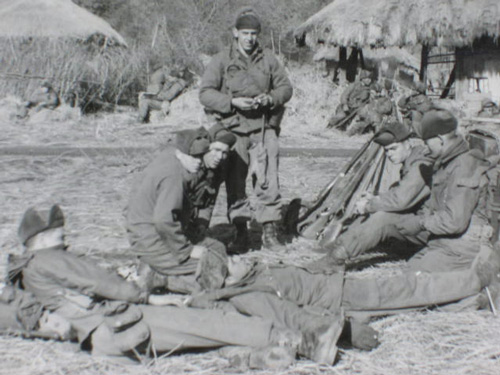
My dad is the second one from the right, sitting.
Colonel Wilson and the rest of the battalion at Umyong-ni meanwhile knew nothing of the fate of B Company at Anui except that enemy forces had engaged it, and that roadblocks were above and below it. Wilson made two unsuccessful attempts to send help to B Company.
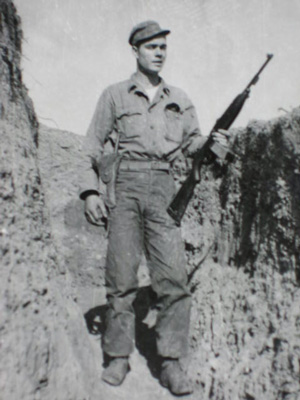
The enemy troops that had closed on Anui were advanced units of the N.K. 4th Division. They were well aware that a mixed force of American and South Korean troops was only a few miles below them. To deal with this force, elements of the division turned south from Anui early on 28 July.

In defensive positions about Umyong-ni and Hamyang, Colonel Wilson's men were on the east side of the Nam River. Col. Min Ki Sik's remnants of the ROK 7th Division and a small force of South Korean marines were on the west side. American mortar fire turned back the small enemy force that approached Umyong-ni. On the west side of the river near Hamyang a hard fight developed. There, the South Koreans seemed about to lose the battle until their reserve marines fought through to the enemy's flank. This caused the North Koreans to withdraw northward. From prisoners captured in this battle Wilson learned of the American defeat at Anui the day before. [43]
When he expressed his feeling that the war wasn't worth it, I told him that he was wrong. I described the huge Korean American community in Los Anglees, how happy and healthy they are. I reminded him of the success of South Korea, that for generations Korean families have grown in freedom, happy and secure. Generations. They enjoyed this because of his sacrifice in that war.
But I understood his feeling, partly. He was speaking personally. I believe he was a casualty of the Korean Conflict. I believe that death put it's hand on his shoulder, and he lived with death for all those fifty years. I will never forget the early mornings when my dad would be the first to awake, smoking his cigarettes in the darkness of the dining room, coffee brewing, alone with thoughts no one could share. There is a character in the TV series "Band of Brothers" who at the end pleads with G-d to let him survive and live so that he can enjoy a simple life. I think this is what my dad did.
He eschewed the ever increasing complexities of modern life to the point of retreat. He would say that he felt he was born in the wrong century and over time it was hard not to thinkof him as a hermit. He said that he wanted to live as rich a life as his military pension would give him. His favorite story was taking off on the highway with his van, fishing tackle and a sleeping bag, a bag of groceries. A rest stop by the highway and a ice cold babbling brook and by sunset, a bunch of fish on a grill to be shared by fellow travellers, vagabonds. I thought of him as an contemporary Indian, Native American (there's Choctaw in the family tree).
It sounds noble but I also think that this was a turn toward death. I remember when he retired from the Air Force. He was 36 years old. He bounced from job to job, eventually settling on being unsettled, reaching for as rich as life as one could have on a military pension. He loved nature and he achieved his goal, but he also retreated from life. He retreated from the challenge of remaking himself, of forming a second act. It was almost as if the events of 1950-51 seared away and exhausted his capacity to struggle. And how can there be a life without struggle?
I can only only touch a few aspects here. I apologise for the rough hewn treatment in this blogpost... I apologise to you, Papa.
My father's story is a huge one (as is my mother's side of the family), one I hope to tell more fully in the coming years.
I listened intently as he talked about the future. Although I had only known him for a few short hours, it was clear that Mr. Qatou liked to talk about the future.
"My life is nearly finished," he said, almost wistfully. "But will be good for my children and my children's children."
"Yes," I said. "It was worth it, no?"
"What?" he asked, confused at my meaning.
"Your struggle," I said. "Now you are free."
Mr. Qatou smiled and disappeared into his memories briefly, then he spoke:
"My life was mostly soldier and prisoner. My children are free."
Admin
Three monumental topics jammed the weekend blogpost production here at the Dennis Hollingsworth blog:
-the recent painting
-Memorial Day and my father
-the EU referendum
Add to this, my monumental capacity of maintaining the pregnant pause...
What I want to do is stuff a few sticks of dynamite and blow the logjam. That means that I intend to hew roughly and hammer out the last painting post and economically fashion the others to recover some forward momentum.
May 30, 2005
Be an Art World
There is no art world
Unless it is first inside
You.
May 28, 2005
Back to the Garden
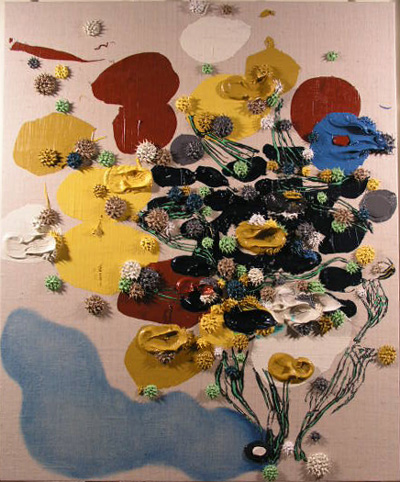
I have shelved an extended text that was originally meant for this post. It was getting too expository, flat footed, overly literal, garishly or even obsequiously explanatory.
No more of that.
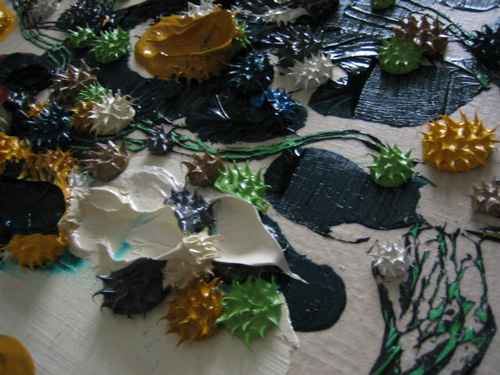
This painting is intended as a prelude for the next larger panel. It began with the expectation to bring Thor's Hammer down (sweeping radical interventions, similar to the big scoops taken out of the previous painting) upon a meticulously ordered and entangled painterly marks or forms... but as I progressed, time dilated and paint dried as fast as my affection grew for what I was painting.
Often, I think of think of the need to formulate a strategy for entering into a painting, and how this conceptual anticipation must be sacrificed in favor of what you encounter along the way. And one of the things encountered/invented along the way was that curious blue form at the bottom. I hazarded another way to lay paint down flatly and the attempt fell flatly (failed).
Slowly, I began to remove it and as I progressed with the erasure, I began to like it and see some promise in it. I also saw an echo of work done back around 1994 or so (I don't have my archive fotos here in Spain, those images will become available when I return to California this Fall). I am always on the lookout for aspects that breathes life into this "wet into wet" project, especially capacities which extend both into the flat (paint applied thinly) and the thick directions. For example, the method of throwing large spatulas of paint onto the canvas and carefully removing them can be seen here, now has a companion in this blue cloudlike blob.
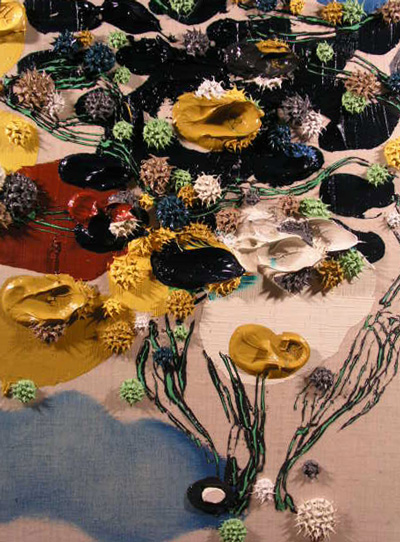
The orignial text was an affectionate Fisking of the Joni Mitchell song "Woodstock", appreciating the drive to return to the garden. But I wanted as well to remember that the way back is not... back... but away and onward along the storyline Judeo-Christian arc that brings us to the other side of the Fall and Expulsion... redemption.
(Arrrgh and Gnash... I feel like I'm trying to rope conceptual bulls with dental floss.)
We can't go back to the garden from the way we came, we can't crawl back into the womb. (I am already erasing huge chunks of text here as I write.) I used to tell my students (architecture studio, Woodbury University, early 90's) that our studio was a garden of Eden and I was the serpent who suggests they eat the fruit from the tree of knowledge (winks and smiles to hedge against the obvious, storytelling artifice in full effect). After they consume the fruit (the curriculum), not everything they do will be embraced as it was when they were babies... when their every act was lauded for what virtues that might be incipient within it and them. They now know the difference between good and evil, between naivete and sophistication. Now, they know what nakedness means. The way back to the garden was with and through the burden of this knowledge. This is a narrative arc that corkscrews like gyres, a cycle that once completed, promises an new horizon.
Ahora

Masaccio The Expulsion Of Adam and Eve from Eden (1426-28) fresco
May 27, 2005
May 26, 2005
Ahora
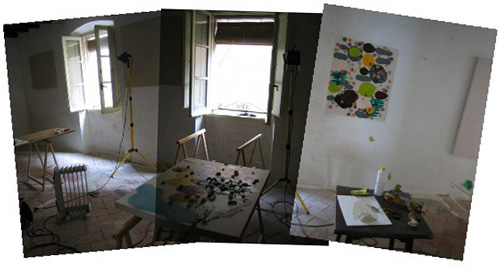
The windows are open because it's Corpus Christi today.
CORPUS CHRISTI
Afternoon: Elaboration of flower mats and altars in the town centre streets
6p.m.: Parish Church ? Mass and procession along the streets with
flower mats and altars
I'm bringing the hammer down on this painting, near the end where things get squishy. I'm lucky that the procession comes by our street.
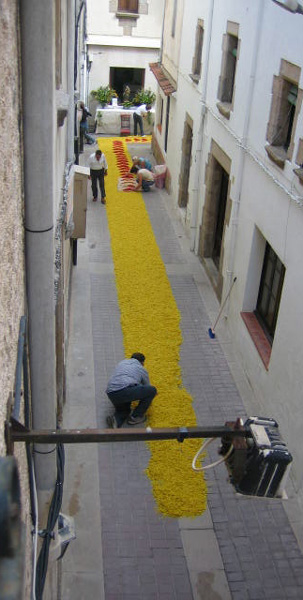
All afternoon, there was a hub bub in the streets. Locals were arranging flowers and decorating the street.
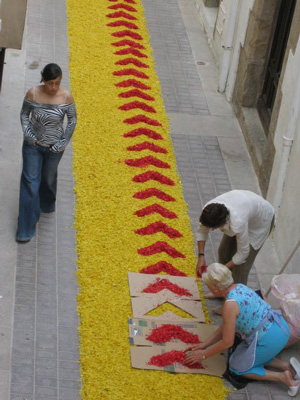
In the last couple of weeks, young kids attended their first communion.
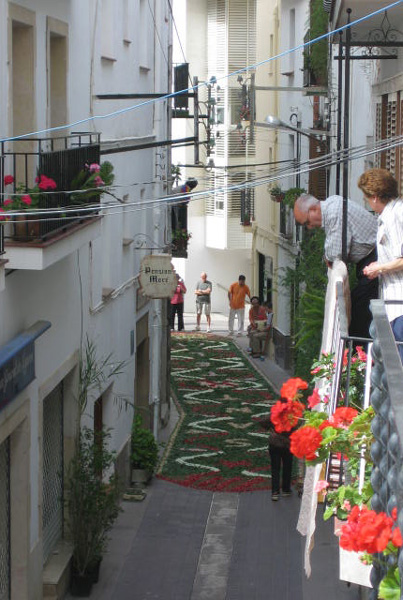
I poke my camera out the front for the view up the street.
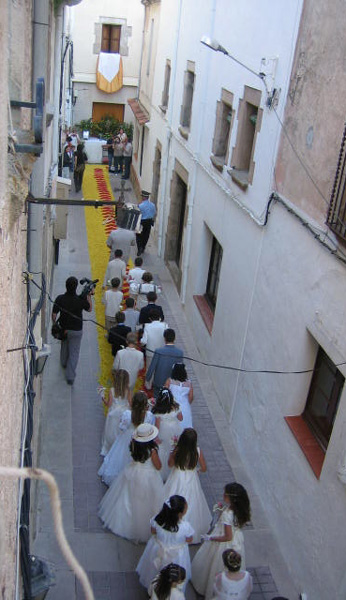
At teh appointed hour, bells rung and the sound of the band grew near. Young virgins' feet trample the pristine and colorful offerings.
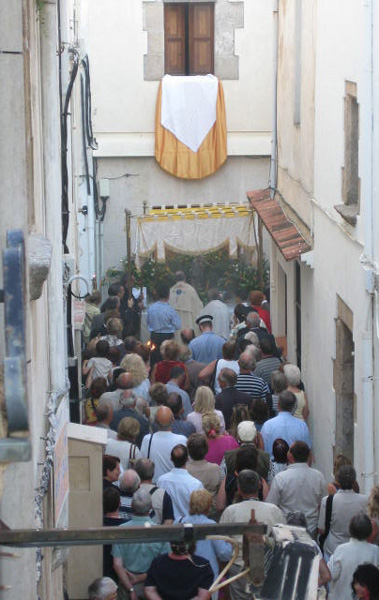
A little later, the priest arrives under cover. Incense and more hub bub. Then people, tourists.
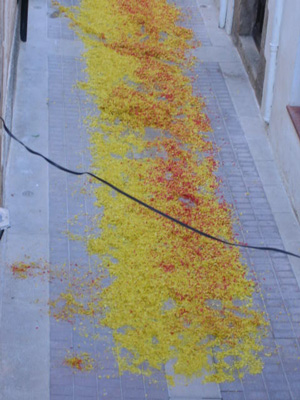
Beauty's Primer
I'm poking around in podcasts now, particularly this one on Beauty from the BBC's "In Our Time".
Very good.
Mark Twain!
Alas:?We wish to learn all the curious, outlandish ways of all the different countries, so that we can ?show off? and astonish people when we get home. We wish to excite the envy of our own untraveled friends with our strange foreign fashions which we can?t shake off...The gentle reader will never, never know what a consummate ass he can become, until he goes abroad. I speak now, of course, in the supposition that the gentle reader has not been abroad, and therefore is not already a consummate ass.?
?Mark Twain, The Innocents Abroad, 1869
May 25, 2005
5am
Woodstock, Joni Mitchell
looped iTunes
Using laptop speakers, don't want to blow out neighbors asleep.
Even the seagulls are quiet.
I came upon a child of god
He was walking along the road
And I asked him, where are you going
And this he told me
I?m going on down to yasgur?s farm
I?m going to join in a rock ?n? roll band
I?m going to camp out on the land
I?m going to try an? get my soul free
We are stardust
We are golden
And we?ve got to get ourselves
Back to the gardenThen can I walk beside you
By the time we got to woodstock
I have come here to lose the smog
And I feel to be a cog in something turning
Well maybe it is just the time of year
Or maybe it?s the time of man
I don?t know who l am
But you know life is for learning
We are stardust
We are golden
And we?ve got to get ourselves
Back to the garden
We were half a million strong
And everywhere there was song and celebration
And I dreamed I saw the bombers
Riding shotgun in the sky
And they were turning into butterflies
Above our nation
We are stardust
Billion year old carbon
We are golden
Caught in the devil?s bargain
And we?ve got to get ourselves
Back to the garden
thoughts of Paul Berman and Juan Carlos and '68.
***
another thought:
line 8=line34
Faustian...
A child of G-d wants his soul free...
Doesn't freedom implies an estrangement from G-d, the devil's bargain?
Or is there a different kind of freedom that exists within an identity with G-d?
Isn't freedom is implied in the Judeo-Christian story? It is central. Maybe the bigger story is first the estrangement and the prodigal return, an arc. An arch-allegory for mankind, lives lived. Freedom is exercised all along the way.
A flaming sword bars the way to the womb of eden.
(pic)
May 24, 2005
Tonic
After reading the last post, so serious.
Click this link and let's loosen up a little.
Venga.
That's more like it.
(from We Make Money Not Art)
Swimmer
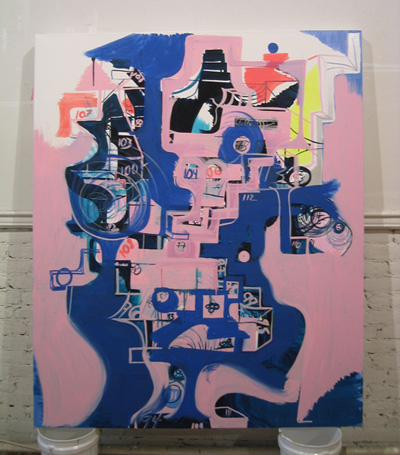
1. Joanne Greenbaum sent me her latest and a hihowareya.
2. Then I see this relish from Chris Ashley, who is in New York this week (giving a talk at the Rhizome thingy):
BLOGPOST IN PROGRESS
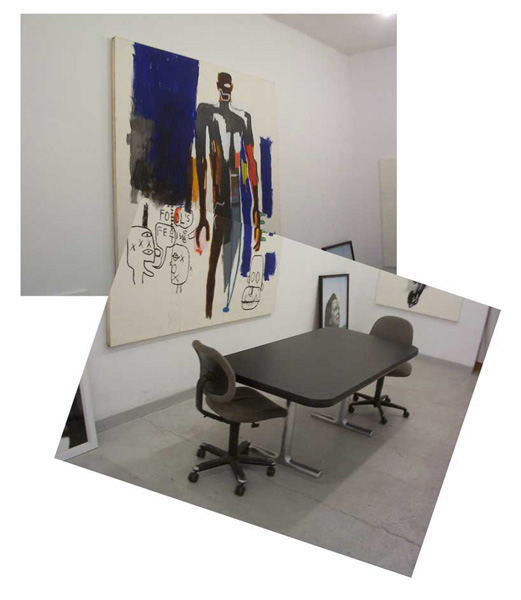
I think about Basquiat's free street, graffitti, notational, additional, impulsive, canvas as a site for the world and the world itself.. how it broke ever so carefully the rigor mortis freezing the joints of composition, a blind eye to the anxieties of how a painting should look.... and remarkable too that it is in a looseness that he escapes the cavernous (like a grave digger) pigeonhole of anti-painting-painting/death of painting narratives... and therefore he would inspire painters of many later generations... (like Joanne?)
3. Chris was generous to post his gallery tour in NY, visiting Tony Scharazzi's Warhol show, pal of Basquait. Hit the Shafrazzi link and you 'll see a slide show of Basquait and Bacon... and late Picasso... awesome.
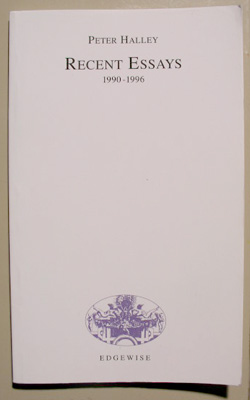
4. I have Aaron's gift of the Peter Halley book. Small and handy. I'm finding a few laudable aspects in it. Funny, though. There is a declaration of importance in its presentation that is undercut by the ruminatory nature of the writing.
This passage seems to stream along like a blog, this as he recounts how he met Andy Warhol:
Nevertheless, an invitation came, via Bruno, to visit with Warhol and get a tour of the Warhol studios, and that was something I just couldn't pass up. Actually, the Warhol people cancelled three times, but finally, in November '86, i did make it over to the last Factory for lunch.
I was really nervous. After all, it's completely strange to imagine meeting someone you'vethought of about every day for fifteen years. When I arrived, there was an array of people, including Bruno and Yuyo Bishofberger, Fred Hughs, and an Australian curator who seemed to be desperate for Factory-style attention, all sitting around an Art Deco-ish dining table, munching on pasta salad. But there was no Andy. After a while he shyly wandered in with a crumpled brown paper bag in which was a gift for Yoyo. He sat down but didn't eat. He just drank herbal tea.
It sure reads like a blog, doesn't it?
Less than an essay, even though it is titled "Recent Essays", a slim 63 pages -seemingly a concise distillation, maybe like the "Origin of the Species" or Newton's "De Analysi"... concise it is not. People in positions of authority write essays, make proclamations, pass laws... with concision.
Do the thoughts of Halley possess authority, as his paintings implicate systems of authority?
Pardon, whilst I meander on...
5. I remember it was Schafrazi who perpetrated a political statement by attempting to destroy Picasso's Guernica... or did he know that the layer of varnish would ultimately separate his spray paint from the strata of the great hand? (I imagine that there are a few artists who would arch their eyebrow at the appeltation... bah.)
Was the artiface behind the Schafrazi act as thin as dried varnish?
Now his gallery thunders.
6. It is worth mentioning that Chris Ashley's breadth of appreciation would include Basquait. With Chris' lush yet dematerialized HTML coded paintings, I think of him as a latter day Sol LeWitt. A lesser mind would be defending turf and pooping on anything different.
7. What bugs me is how the presentation of the Halley book portends authority while it is nearly a diary, more intimate than anything else. Why does the appearance of a figure of authority ring false to me? Enter, this article (for the first time in years do I link to the LATimes) about the apparent demsie of criticism:
But many newspaper and magazine critics pine for a golden age when giants walked the Earth: When the imposing Clement Greenberg was shaping modernism in painting, the biting H.L. Mencken was exhuming the reputation of Theodore Dreiser, and the impious Leslie Fiedler found unsettling Freudian meanings in the novels of Mark Twain.
They were giants in the past when freedom was more limited than it is today, and privilege was channelled through carefully tended and defended social structures. The Luddite's swan song: 'Where'd it all go?". All that is blowing up now, thank G-d.
The article quotes the great Dave Hickey:
Dave Hickey, an art critic best known for the book "Air Guitar: Essays on Art & Democracy," doesn't think the Internet is the problem. "But I do think that we're over," he says. "Being an art critic was one of those jobs like nighttime disk jockey or sewing machine repairman: It was a one- or two-generation job."For Hickey, art criticism lost its luster and excitement the same time art did. "There was a sense that things had a forward tilt," he says of American art after World War II, when it seemed to be moving toward a consummation. "Jackson Pollock changed the way the world looked, Andy Warhol changed the way the world looked."
But the high couldn't last forever, and the power went to the curators.
"I'm like Wolfman Jack," Hickey groans. "The times have passed me by."
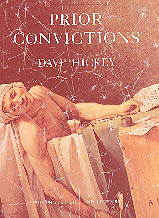
I don't think he's worried too much. I think of him as primarily as a writer, a player on the field rather than a referee, especially after I read his "Prior Convictions", his swan song as a writer of fiction. He wrote that the tendency to cannibalize life for source material soured his experience in fiction. He likes the distance in art writing, and it is this distance that insulates him from the vanity of being declared the king of criticism.
Kings are quaint anyway.
8. I'm scratching an itch here.
Meade Arble told me two things: that there is a writer in me struggling to get out... and that this blog is a strategy for procrastination.
(!)
Maybe. I used to pace back and forth. Now I blog.
But I am already writing, so I don't have to become a writer, especially if one becomes one when one is published by a publisher. Movable Type is my publisher. And I've always swelled the pregnant pause before every painting. One of the worst aspects of Sam Francis' practice is that he never hesitated, never edited.
Although I can identify with the opening scenes in "Sideways". I too am a wretch.
Blogs are part of the story of the expansion of freedom in the 20th and 21st centuries. A big part, I'll bet.
Consider this:
-The MOCA Show "Public Offerings" declared that the only valid subject of art is the artworld as a system. The totalization of the system, an individual's experience is nowhere to be found.
-The art world system runs on prestige.
-Agents within the artworld have been interchanging roles and yet the overall structure has retained its overall form. Curators becoming educators for example (the recent article in X-tra, Ann Walsh's interview with Larry Rinder, (current issue, not online). More permutations exist, too many to list here. But the diminution of the role of the ciritic is the first signal of the change in the overall structure of the system.
-Prestige will flow differently in the future, ojal?, but it will flow.
9. I consider this blog as a part of my painting, a bibliographic entity. A historical resource. Better than that, a place to satisfy curiosity, to have fun doing it. It's the act of putting things together and sitting back and reflecting upon them.
Joe Marioni once asked me "...if people wanted to draw representationally, why not take a picture with a camera?" At the time, I responded: "Maybe there is something abstract in representation. We see with our brains, and through the eyes." But now I see that I have ported out much my my representational impulse out into this blog.
This blog is my sketchpad. The camera-plus-computer program, my pencil. It's going to get more vivid as technology evolves, it's going to be a lot of fun.
BLOGPOST IN PROGRESS
Masson's Tossa
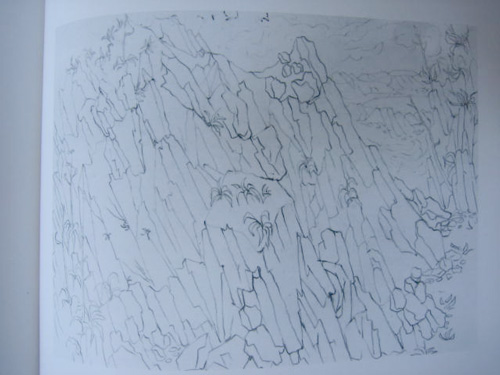
I wanted to share another of one of Joan Panellas' loaned books(Joan operates a gallery here in Tossa, a blogpost on him to come soon) on Andr? Masson, drawings of Tossa done in the 1930's.

From the link above:
Although Masson is most often associated with Surrealism, his work evades definition through any one twentieth-century movement. In some ways, the identification with Surrealism has been confusing. Not only has it focussed attention on a partial aspect of his career, but has obscured profound differences between them. If it is true that some of his finest paintings were produced when he was closest to Surrealism, it is also the case that they were generated by deep tensions: as he wrote himself, "Painful contradictions are sometimes the source of the greatest riches".Feel the pain.
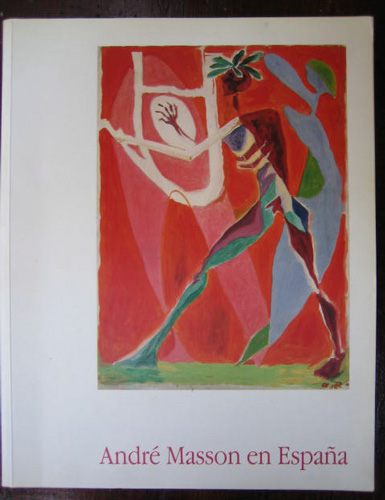
May 23, 2005
Alberto's Visit
So there I was, staring at blank linen. The door bell buzzes.
It was Alberto: "Do you have a minute?"

He wanted to show me his first painting done since he ordered paint from Schlieper's, the place I order my supplies online from in Brussels. So he busted over on his bike, panel in hand.
Kinda excitable.
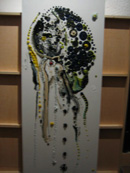
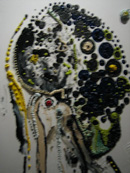
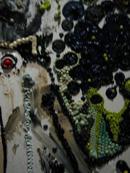

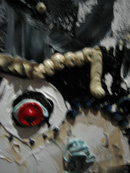
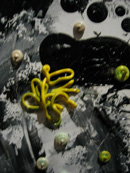
Here's Alberto's first painting.
He wanted a hard crit, "Be honest, I can take it."
I said "You're doing good, keep on going. There are fine and inspiring qualities of what you've done here and you should make another." This wasn't the time to get into a grinder of a critique. I was his first painting after all (technically, he's an art student, ending a haitus).
He was worried that I would think he was copping my moves. I reassured him. I have an open source policy (as you, my blogaudience will see soon in a blogpost coming soon about the tools of my trade), I don't believe in hoarding ideas, especially technique. I think character is the final arbiter between the merely excellent and the exceptional. The issue is not that of following a recipie but of paying attention when you are painting. And I think he is paying attention.
"Think in terms of ten." I think that spooked him, his eyes got wide. "Ok, five then." Better. "Just do it again, do another one. Movement."
This was not the time to take out the tool kit for the full crit.


He rode home to paint the next one.
Me too.
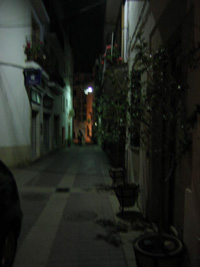
Remarkable, no?
Luego
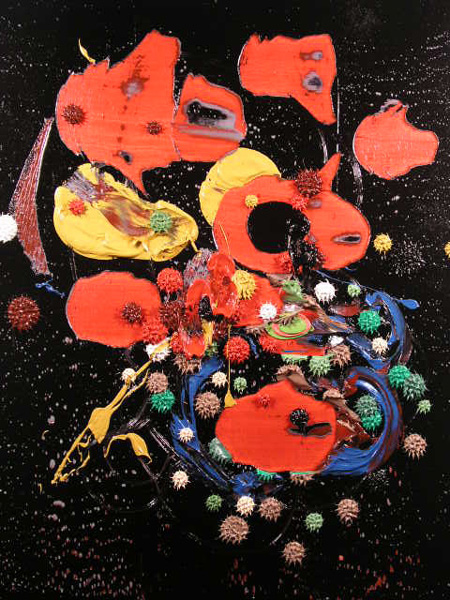
I hope you don't mind if I keep a little nonverbal regarding the whys and wherefors of this painting. If you are following closely (here and here), you might see a tacking back and forth and a directional course that results from the maneuvers.
I usually like to combine near and far camera shots of the paintings in this blog. I think this is a fair translation of what you see en vivo/naked eye. I liked to zoom in pretty close and step back in stages. The extreme close ups combined with the overall view is a fair representation of my experience in the studio. Sometimes though, I think some people get confused by taking the near for the far, so here I have relaxed the zoom in the first shot. Here is the overall:
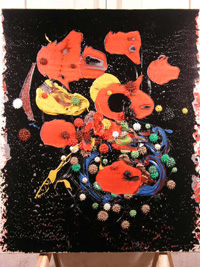
May 20, 2005
Manolo
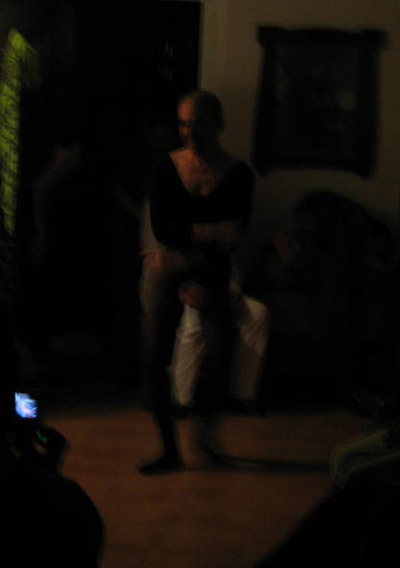
This is such a great image, I had to see it again in the blog. Bigger.
Masson in Tossa
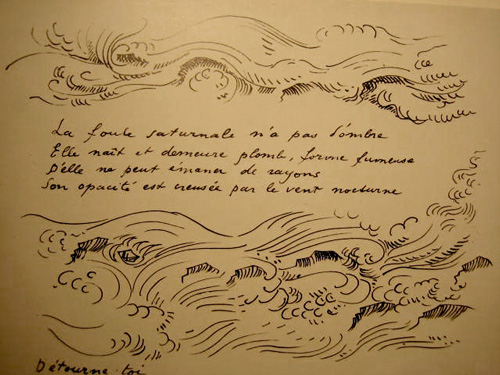
Andr? Masson once lived in Tossa de Mar.
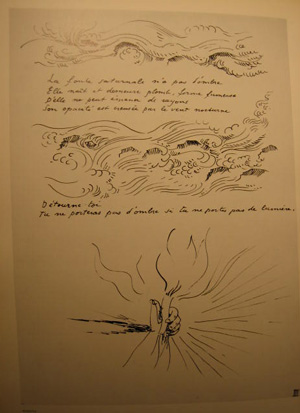
The whole page. This book, lent by Joan Pannellas, gallerist in Tossa.
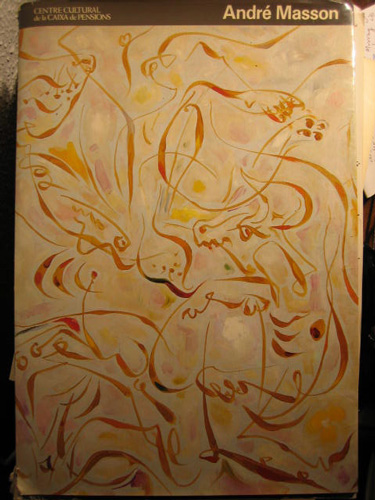
More on Joan to come.
May 19, 2005
New and Improved

In the "be careful what you wish for" department:
Trump slams Ground Zero plans
NEW York property tycoon Donald Trump has unveiled his design for "bigger, stronger and better" twin towers to replace the World Trade Centre destroyed on September 11, 2001.
May 19, 2005
From: Agence France-Presse
Donald Trump
Bold plan ... Donald Trump explains the virtues of his new towers / AFP
Denouncing the existing plans for rebuilding Ground Zero as the "worst pile of crap architecture I've ever seen", Mr Trump argued that erecting two new, even taller twin towers was the only valid response to the terrorists
Towers aside, the interesting issue is the ground plane, the streets and how the towers touch ground, negotiating a memorial.
I wonder what New Yorkers think about this?
May 18, 2005
Swimmer
forming conceptions
*
breaking preconceptions
*
all conceptions become preconceptions
***
Link: Dan's Iconoduel's "Looky, Looky"
They are getting into it over Kuspit; history and criticism; the Modern and the Contemporary. Specifically, Kuspit's recent "The Contemporary and the Historical":
There may be a history of modern art and a history of traditional art, but there can be no history of postmodern art, for the radically contemporary can never be delimited by any single historical reading. Even if one was a Gibbon one could not fit all the pieces of contemporary art together in a unified narrative. In postmodernity that is no longer any such thing as the judgment of history, only an incomplete record of the contemporary. If every piece of art is contemporary, no one piece can be valued more highly than any other, except from a certain psychosocial perspective. But every perspective turns out to be procrustean because it shuts out art that contradicts its premises.
Smart fellows all. But they seemed confused... or rather, I don't feel like joining the debate in their terms. I see history a little differently, maybe it's because of my own peculiar timeline.
Are they are throwing up their hands over the task of describing the PostModern? (well, nickname me "Gibbon".)
Don't give up so fast, fellas. The art world may not be the best vantage point from which to view history. Art people by and large seem to be too inside to see the contours clearly. (But I should be wise enough to cautiously pull back from claiming to hold onto the certain panoramic view.)
Perhaps our terminology is mangled:
The Contemporary is what the Modern used to be, except we calcified the original term with historical narrative. Language is fugitive, plastic, apt to be spoiled or badly used. Now that we have museums of modern art, we need a name for the phantasmagoria that is art-in-the-making....
***
I think of the Didion quote that I flag in the colophon:"We tell ourselves stories in order to live... we look for the sermon in the suicide, for the social or moral lesson in the murder of five. We interpret what we see, select the most workable of the multiple choices. We live entirely, especially if we are writers, by the imposition of the narrative line upon disparate images, by the "ideas" with which we have learned to freeze the shifting phantasmagoria which is our actual experience." (from "The White Album", Joan Didion)
A history named is not fixed, or an impediment to another history named... one sermon in the suicide won't sideline the moral lesson in the murder of five. So there is no straitjacket of interpretation that Kuspit seems to fear.
We live in phantasmagoria but we move through it by freezing it... then breaking it... so that we may freeze it again in another way.
Fluidity.
No wonder so much of our thinking seems like so much stone. Impass. Deadlocked. Cold sweat from the "end of history". Life in the river delta. Mosquitos. Methane. Sunburn. "Stella!"
***
Then I stumble across this link, an article on "Roger Cass, the Last Optimist" (I like optimists) and I become fascinated by this passage:
In other words, Cass learned an intensely calming lesson: Change is a vastly overrated concept. "Things don't change," explains Malcolm Tulloch, 50, one of Cass's colleagues who runs Tulloch Research, a London-based hedge-fund advisory firm. The way Cass sees it, the future only has two tricks up its sleeve: bigger and smaller. Good times alternate with bad times at predictable intervals. If nothing changes much -- if the fundamentals stay the same -- then you can actually see what's coming next.It is a lesson that Cass learned from the writings of a French historian named Fernand Braudel, who conceived the notion of projective history: an oxymoronic way to discern the future by studying the past. According to Braudel, you can learn only so much from change -- from the movements of great men, wars, and treaties, from CEO hirings and firings, or from the rise and fall of big companies. The future can't be found on the front page of today's newspapers. Rather, the future can be found by looking at what doesn't change. By studying the eternal truths of history, you can see what has to come next.
Cass, like Braudel, works at a level where things don't change. He studies in detail the small, permanent features of the economy: interest rates, housing, loans, money, taxes, energy consumption. These things are immortal in economies. They have been around ever since the time of Hammurabi, and they are still around today. Trade is as old as the sea itself. Consumer confidence is an eternal condition. Technology has always existed. Trace the deepest movements of economies, and they will tell the story of how change actually occurs in the economy. The message that economies carry is that change is very rarely new. Instead, it unfolds in clear patterns. It unfolds in waves.
I think of how this can help us view art history in a different way than before. (Do you want to get dizzy? Find the section in the article entitled "Sidebar: The Five New Economies" and try to match art history to the five historical waves described.)
I begin to realise something that I had always (unconsciously) assumed all along: art history alone is insufficient to describe it. Other histories are needed. Context.
***
I google for Braudel:
Until the turn of the century, traditional history was built around the acts and facts of "great men", political and military personalities who became the stuff of legends: Alexander and Caesar, Gengis Khan, Louis XIV and Napoleon. These exceptional individuals defined the scale of history; their deaths signalled a change of era and also of books and authors.Without contesting the value of these accounts, Fernand Braudel nonetheless proposed a shift in the historian's focus. Beneath the rapid succession of events on a human scale, which the historian likens to ripples on the ocean's surface, Fernand Braudel attempts to charter a course through deeper waters to find the slower currents typical of the history of human groups relating to their environment, the structures that shape societies, be it essential trading and sailing routes or mentalities.
With Braudel, the subject matter of history changes because the time frame of history changes. The swift pace of events, the short-lived and dramatic moments of battles are replaced by the lengthy rhythms of material life. However, with such a change in perspective, he has also had to rethink history itself. Braudel demonstrates quite clearly that history does not exist independently of the historian's gaze. As in all knowledge, the historian intervenes at every stage in the making of history; indeed, history per se does not exist, only past phenomena submerged under the dark cloak of all-consuming time. The approach adopted by Braudel leads him to tell of a history that not only calls on witness accounts and psychology but also on geography, political economics and sociology. Braudel introduces new disciplines like new colours on the palette of history: he brings social sciences to history.
A two-speed history
Blog Talking
It looks like Rhizome.org has had (or is having, at this moment) it's second "Blogging and the Arts" panel discussion, featuring Chris Ashley among others on stage. Full info via Tom Moody.
I wonder what they are saying over there?
May 17, 2005
Elbow Room
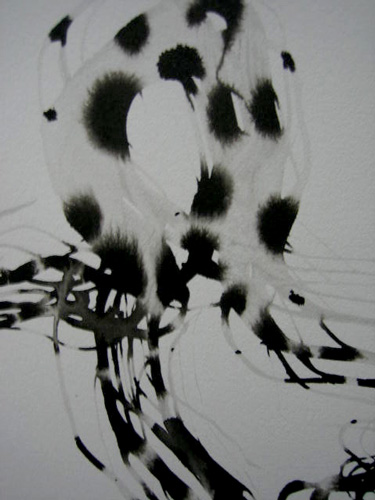
This is an older sumi ink drawing, done long before the day of fishing. It does appear to demonstrate an affinity for octopus, I must admit.
I'm setting up tables downstairs to revive my sumi stuff.
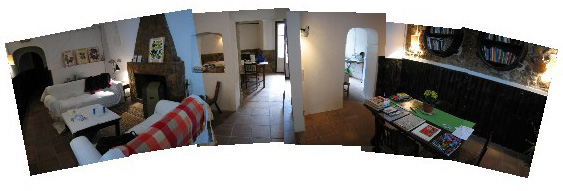
It's time to clear the tables and spread out a bit. A little heat from the estufa still takes the edge off the night. I like to see my books out, many projects in progress. A nip here, a nip there.

On the site of our future kitchen, a room to draw in.
On the hotplate, a stew.
Music: I've just downloaded "Kind of Blue" from iTunes. Again. My third copy. (Don't ask why.)
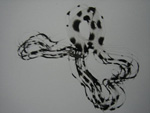
(for scale)
Rainy day, perfect.
Ahora

I love a rainy day.
...er, night.
Excellent for the studio.
May 16, 2005
SPACE WEATHER WARNING

It looks like fished under gamma or whatever rays. Check this out:
May 15, 2005 ? Forecasters at the NOAA Space Environment Center in Boulder, Colo., observed a geomagnetic storm on Sunday, May 15, which they classified as an extreme event, measuring G-5?the highest level?on the NOAA Space Weather Scales...Click here"This event registered a 9 on the K-Index, which measures the maximum deviation of the Earth's magnetic field in a given three-hour period," said Gayle Nelson, lead operations specialist at NOAA Space Environment Center. "The scale ranges from 0 to 9, with 9 being the highest.
via Drudge.
Now it looks like it might not have been so bad after all:
UPDATE:
Scientists Say Sunshine May Prevent Cancer
Email this StoryMay 21, 1:15 PM (ET)
By MARILYNN MARCHIONE
(AP) Graphic shows three ways to get vitamin D; two sizes: (AP Graphic)
Full ImageGoogle sponsored links
Credit Repair Solutions - Bad Credit - No Credit - Low Income Our info works for any situation.
BadCredit-Central.info
Bad Credit Loans - Find Loans, Credit Cards and more! Bad Credit / No Credit? No Problem.
BadCredit-Savvy.com
Scientists are excited about a vitamin again. But unlike fads that sizzled and fizzled, the evidence this time is strong and keeps growing. If it bears out, it will challenge one of medicine's most fundamental beliefs: that people need to coat themselves with sunscreen whenever they're in the sun. Doing that may actually contribute to far more cancer deaths than it prevents, some researchers think.
The vitamin is D, nicknamed the "sunshine vitamin" because the skin makes it from ultraviolet rays. Sunscreen blocks its production, but dermatologists and health agencies have long preached that such lotions are needed to prevent skin cancer. Now some scientists are questioning that advice. The reason is that vitamin D increasingly seems important for preventing and even treating many types of cancer.
In the last three months alone, four separate studies found it helped protect against lymphoma and cancers of the prostate, lung and, ironically, the skin. The strongest evidence is for colon cancer.
Many people aren't getting enough vitamin D. It's hard to do from food and fortified milk alone, and supplements are problematic.
(AP) Dr. Michael Holick, Ph.D., of Boston University, poses in a tanning bed at the Boston Medical...
Full Image
So the thinking is this: Even if too much sun leads to skin cancer, which is rarely deadly, too little sun may be worse.
May 15, 2005
Last Day in Tossa
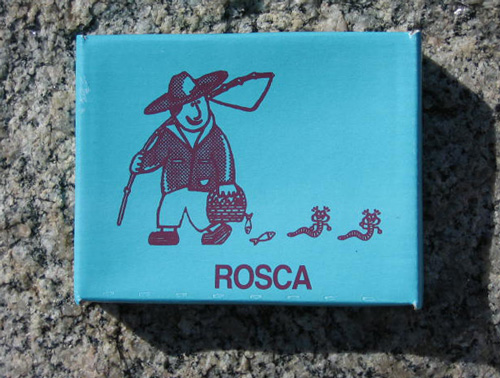
When the fish hook dug into the tip of my right index finger, I took that to be a sign to slow down and think about what I'm doing. It was a gentle reminder, the tiny jewel like barb dug into the callous and it grazed a shallow layer of bleeding flesh below. A little nip it was, enough to grab my attention.
It was Stephanie's last day in Tossa before she flies off to Los Angeles to work for Guess? Jeans as the design director for Young Contemporary division. She was excited about it: the prospect of seeing old friends, reuniting with Guess? inc., living in temporary housing across the street from the ne plus Angelino Farmer's Market/The Grove, shopping heaven. Imagine this transition after living in Tossa de Mar for over a year. The saying "it's all good" certainly applies here...
...except that we will be apart for most of the summer while I stay behind in Tossa to prepare for two exhibitions to come.
Kiko promised to take us out fishing and today was the appointed day. Knowing that Stephanie fights the custom of partying all night to the break of dawn (as do Kiko and Teresa most times do), he half teased her with plans to celebrate her last full day in Tossa with a morning fishing expedition, a bar-b-que in the afternoon, a dinner late inthe evening and a party at a friend's place to cap the night off. He was gaming to send her off to the Barcelona airport from the party itself.
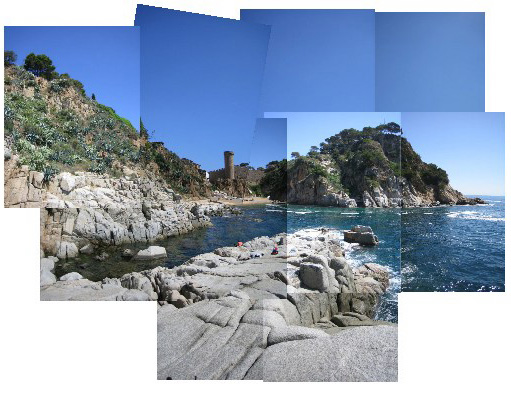
My dad would have been proud of me. He loved fishing, he loved nature, the only place he was truly comfortable. He had prepared his will pretty badly but to cover for him, I took his request for his ashes to be scattered at sea -literally. What body of water is more of a sea than the Mediterranean? I chose Spain because that was where he was probably the happiest in his life. I chose Tossa because my mother and her side of the family chose it to vacation/settle here. I chose the Codolar Cove because its scale was intimate and human... the cove is like an embrace... and releasing his ashes while treading water at the center of the plume seemed like re-embodying him there in nature itself.
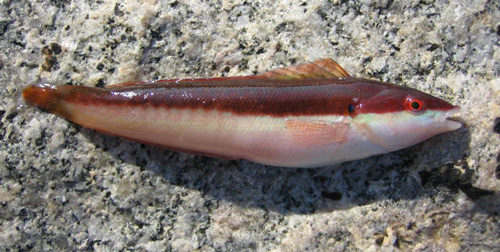
First catch.
We caught about thirty fishes on this day. In the summer, you can swim through schools of them. On this day, we ate the hapless ones who bit the worms impaled on our hooks. It was a funny feeling, knowing that my dad's ashes were scattered here and these fishes must have imbibed his molecules over time and on this day, we were about to eat them up in a skillet with a little salt and olive oil and pan Catalan.
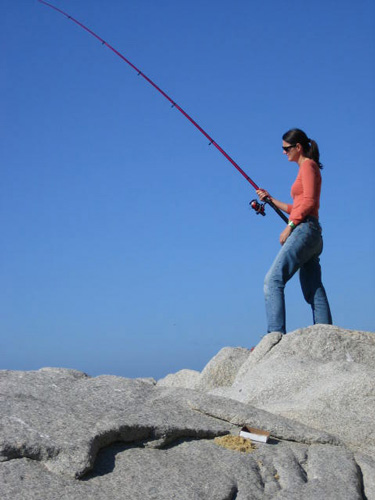
Stephanie's dad was an outdoorsman too, but of a different kind. He was a speedboat racer. Her family would camp by the rivers and lakes of Southern California and take part in competative racing. She was a good skier herself, snow or water.
It didn't take her long to catch on to baiting and casting the fishing rod out to sea.
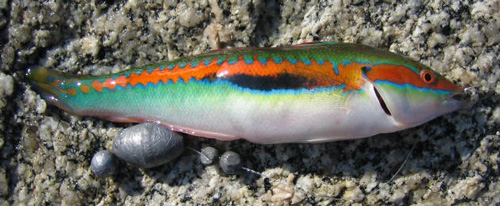
I must be too urbanized, as I found myself feeling a little sad to snuff out these beautiful little lives. I whispered apologies as I ripped the hooks from their throats, their eyes bulging out. Do they feel pain? Is pain the same for a little brain as it is for our bigger self conscious ones? (I read an article once that claimed that pain is different in a self reflective creature than for one that is not).
I promised to cook them well and savor their flesh.
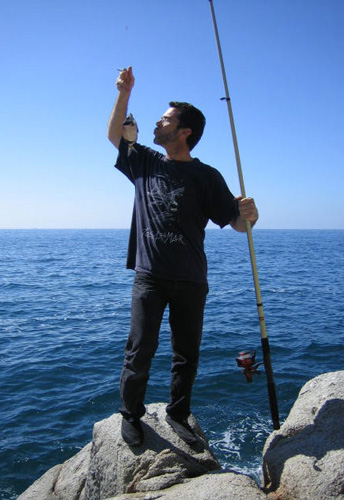
What a life Kiko has here. He makes certain that he will have his month and a half off in the summertime. He makes sure he comemorates the parties and celebrations that marks the year. And boy, there sure are many such co-memorations, social punctuations in the claendar here. For him, life has a purpose and that purpose is to savor it... kind of like my dad thought. In my many fantasies about alternative family histories, I daydream that my dad had settled in Spain after he retired from the Air Force.
He would have been an excellent Catalan.
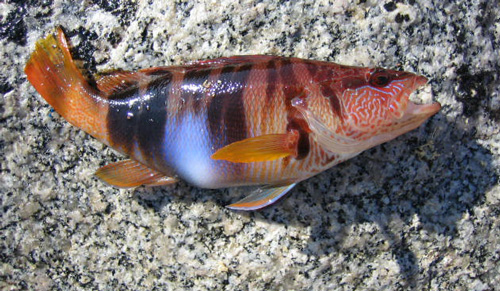
I asked Kiko for a list of the names of the fishes we caught: Churiola, Serrano, Gombid, Espadar, and Sargo.
At one point, I snagged an octopus. My fishing rod bent in an extreme degree, straining in a fight, I managed to raise it in boiling surf. And as I got the creature near the surface, it managed to grab a rock with a tentacle and it was over. In a moment, the line snapped and the prospect of simmering it's fine body over hot coals and a little garlic and extra virgin olived oil and a pinch of salt... over.
i'm glad it got away.
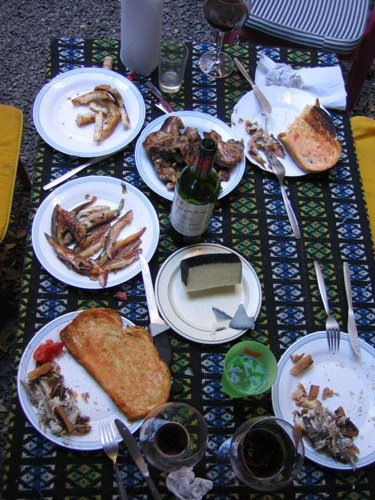
Nacho, his wife Leslie and their daughter Berta arrived for the three day weekend. We bumped into them on our way back to Kiko's for the afternoon bar-b-que, they had just arrived into Tossa from Barcelona for the holiday weekend. I remember when I could just barely hang on when Nacho talked. I would follow a conversational thread and often lose what wisp I had of it, hoping to reassemble the drift of the conversation... or as a last ditch effort , pull the rip chord: "No entiendo.".
Eyes wide.
Blinking.
Head shakes slowly from side to side.
Now, I can track almost every sentence. And I can certainly keep on top of the conversations in Castellano. Here's a shout out to our Spanish teacher, Elena Obach at l'Study! I can bat the ball back over the net, even though I still maul the verbs. Lord, I must sound like an blithering idiot to the locals.
He told me that he's working with Americans. And he talked about American style, smiling like "You poor guys are all messed up.", a big grin on his face. "American style." he says with a whip of the head. Hombre.
What is American style of motorcycle sport? A single objective: explosive speed.
The Spanish way is agility and accelerlation. Look at the tracks:
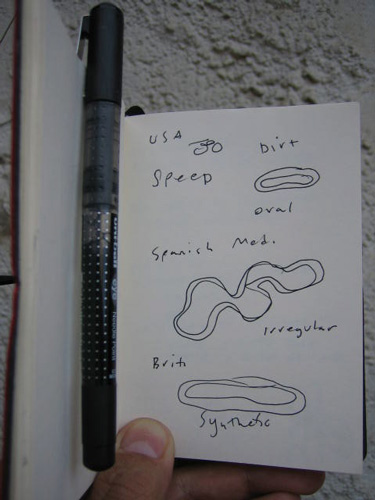
The Spanish style has more dimension. It is more than mere complexity, there are more ways of failing and therefore it is more hazardous, peligroso. The former is perfection in the service of a singular goal, the other, a dance where you accelerate into turns as your knee kisses the piste.
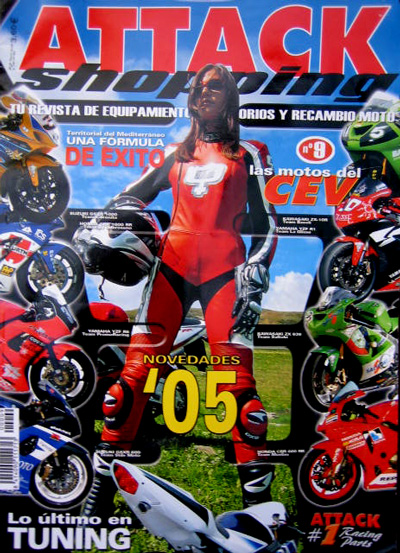
Going after a singluar objective, perfection is the American way. American bikes must appear perfect, flawless. The spirit is monomaniacal and there is no tolerance for anything less. The result is a little transhuman, inhuman perhaps, overdriven certainly. Unjust. This singular overdetermination contrasts sharply against the dimensionality of the Spanish way. And isn't life less like the linearity of a speedometer and more like the contraposto of combined perspectives?
?Hombre, venga!
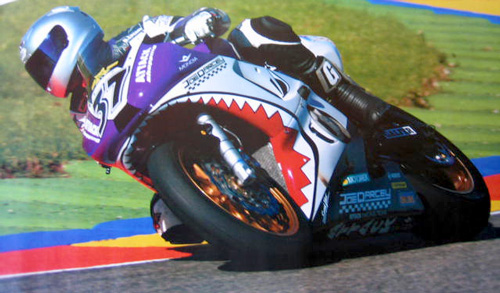
And so it went, that afternoon, the beginning of the summer.
I asked what the holiday was that rendered the three day weekend. No one really knew. Shoulders shrugged. It has something to do with the Virgin or some such thing. But how Yanqui it is to ask the nature of the holiday? This, as if one needed a reason for it. How linear!

The Spanairds are tough partying folk, but even a day long festival schedule needs to schedule a few breaks para descansar. We agreed to meet up again at Bar Josep to watch the soccer game between Barcelona and some other team I'm not the one to get too specific here. I know less than nothing about sports. Colored jerseys, a big field, the ball pap, pip, pap back and forth, lots of action but precious few goals and points scored.
I mostly watched the reactions of the audience, the game in their eyes. They moaned and gnashed and when it became apparant that they were going to win, the whole town agitated. Petardos, firecrakers started to go off in the street. Blood curdling cries of men and man-boys pierced the night. Air horns, car horns and singing "?Ole,ole, ole, ole!", they all know the song young and old alike.
The party reassembled at Nacho and Leslie's place, another super sweet habitation in the center of town. Their apartment, a triangular plan that ascends three floors, ending with their daughter's bedroom above in a crows nest that frames one of the towers in the their window.
Nacho explained his theory of managing a racing team: "You must have five factors that must perform perfectly: the pilot, the team, the tires, investor and logistics. He went on like a philospher general. He is the Patton of the motorbike world.
The hour of two in the morning approached. It was time for young Berta to go to bed (she's 5 years old, so cute). It's common for the kids here to hang out in the bars past midnight with the parents. But even the kids have a an "early" bedtime as the parties take a more adult turn.
And we had a date to go to a party at Manolo and Jose's place. Manolo and Jose are -or were Kiko's clients. Kiko refurbished their building, an old structure right next door to Bar Josep. They are owners of a chain of perfume stores in Barcelona and elsewhere. Like Nacho, these two maintain a second vacation home in Tossa. Their place is nicely put together, Kiko did a great job.
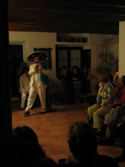
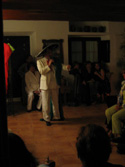
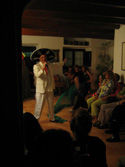
Knocking on the door, a porthole opens and we were admitted inside. We could see Maria and Manolo using the stairs as a backstage. We were just in time for the evening's performances.
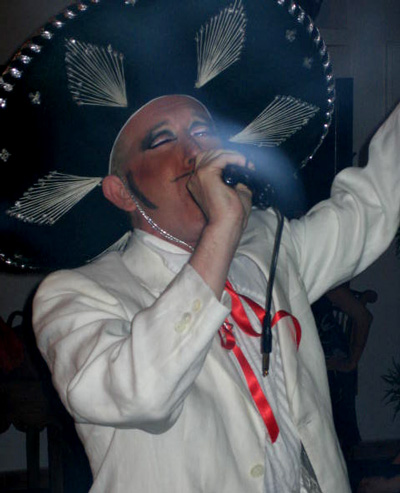
Mexican karaoke with Flamenco flourishes.
Manolo was into it.
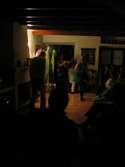
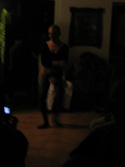
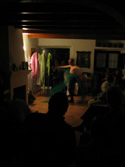
Another song and Manolo begins a strip tease. Discarding the white suit piece for piece, he revealed his body in a black leotard. A rose, the only ornamentation.. planted on his crotch.
Hips gyrated. He worked that rose hard.
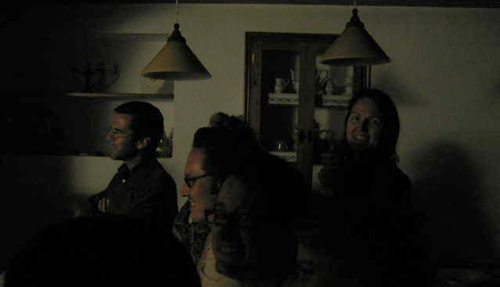
A golden moment.
Stephanie had three hours until we had to get up for our appointment with Se?or Bartolo, the taxi driver, to take her to the airport. Kiko's devious plan to pour her into the taxi directly from the party was working perfectly.
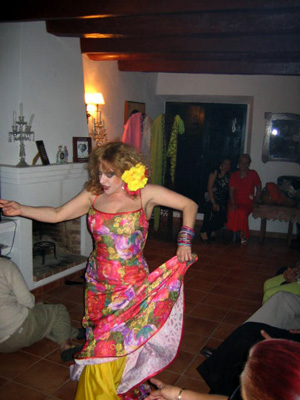
I have very little biographical information on Maria. I know she is a professional singer. She has several recorded CD's and a career of note.
Husky. Sultry. She's been there.
I first met her at seven o'clok that morning when I arrived at Kiko's place. She, Manolo and Teresa were winding up a night's festivities with the sunrise. What strong constitutions they have!
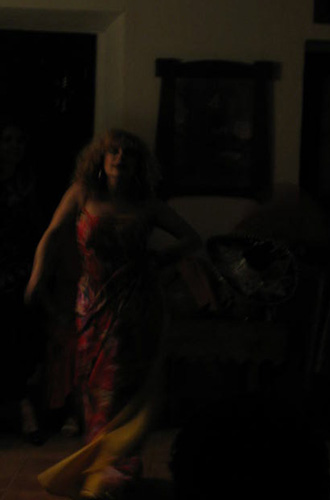
I like this pic better than the flashed one below. A camera flash seems to betray the effect of the stage. For documentary purposes, however brusk, here it is:
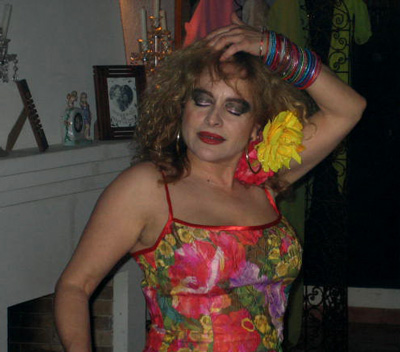
Musica Sevillana.
A woman wearing a leopard print click clacks the castenets. I want to buy some castenets, maybe I can click clack in a PruessPress jam session someday.
But what a night it was. It was a wonderful way to toast the end of our first year living in Tossa together. An ending and a beginning of a life lived between two cities, Los Angeles and Tossa de Mar. Our pendulum life has begun to swing between two places, torn and loving it.
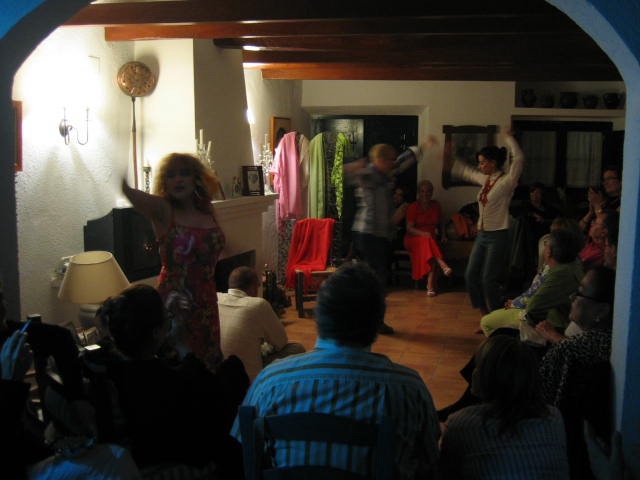
May 13, 2005
Chill
Spanairds want you to take it easy:
1-Relajate
2-Calmate
3-No pasa nada
4-No te preocupes
5-Tranquilo
6-Paso a Paso
7-"La pacencia es la madre de ciencia."
CAPRABO
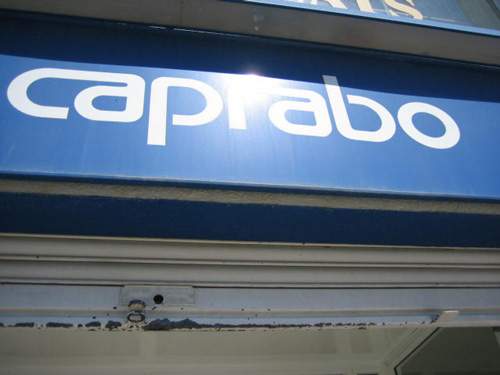
I think I've kept my blogging audience in the studio a bit too long, with all of those "Ahoras" taken indoors, living like mushrooms, troglodyte that I am.
And the refrigerator is a bit empty, it's time to go to the grocery store and replenish food.
Let's get some sun and go for a walk, ok?
***A note of caution (bandwidth alert!): this particular blogpost contains sixty pictures. It's a slice of life kind of thing (art snob alert!), no artworld stuff to speak of...
...but isn't the division between art and life a little arbitrary, no?

Got your keys, sunglasses, camera, grocery lists, handcart, check?
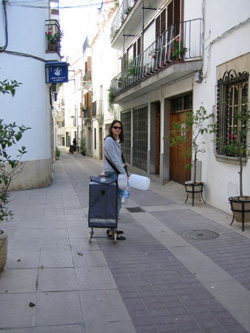
Oh yea, and we are going to recycle the plastic bottles too.
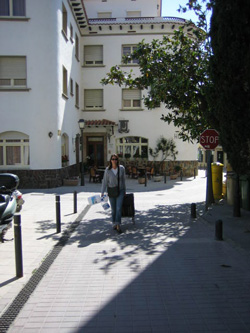
Passing by the hotel Tonet and the Church...
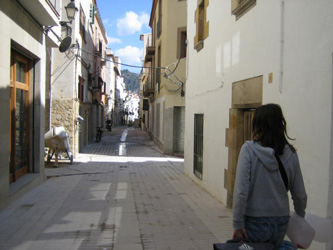
We're taking a slight detour to deposit the recycling stuff. This route takes us through streets that are under construction. Tossa is installing natural gas for the first time and streets are sequentially getting ripped up in the off season. Our street gets it next winter.
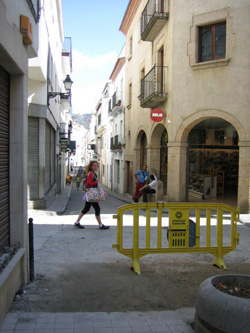
This is the lull before the storm, of tourists that is. We've been warned about Tossa winters. My mother for one, describes it as "the Shining". But I like it (of course, I'm in my studio most of the time.), I like having the streets to myself. Stay tuned for summer street fotos to show the difference.
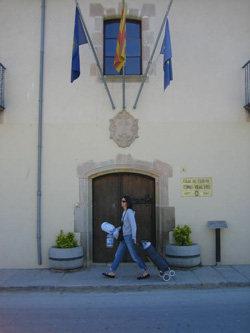
Our walk takes us past the house of culture, a community center outfitted with meeting rooms, a small theater and classrooms.
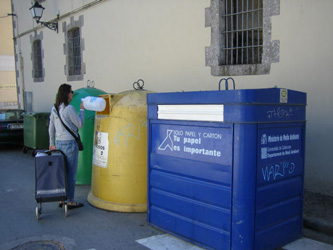
Yes, virtue incarnate! Mother Earth sighs in relief!

We meet Paco and his dad along the way. Paco works for Kiko, a hard worker, a good man he is. He cleans up real good too, it's funny to see him out of work clothes. I like his bearing, his civility, a real gentleman. It's nice that he takes his dad out for a paseo.
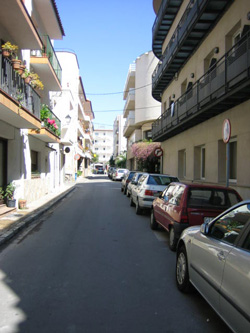
This street is flanked by hotels. Located in an out of the way part of town, these two hotels on the right are always packed with tourists in the summer. It's as if they are content to hang by the pool and never leave the hotel. Strange.

I'm glad I was able to capture Stephanie, the side of this nice old building and the dude on the quad. People don't usually strap on their helmets, chin straps can be seen flapping in the breeze or clipped up over the top. Helmets are used like ballcaps. Old guys like this one are too cool for school to sport the helmet.
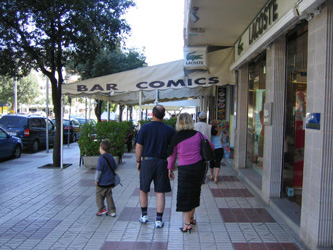
A right turn onto the main street. Bar Comics is a Dutch owned bar, so I've heard. We're going to take a pit stop at the coffee shop La Granja just a few steps ahead.
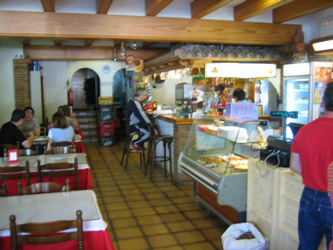
Here we are, ready for a little coffee and the best croissants in Tossa.
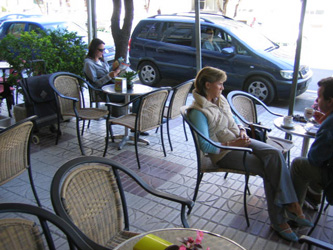
The weather is good, so let's sit outside.

Panorama, take it all in.
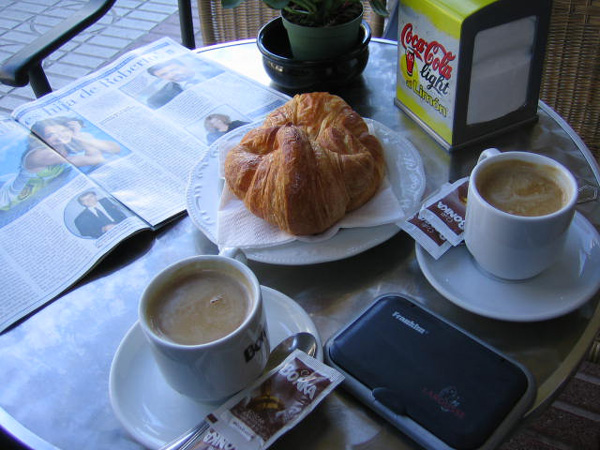
The cafe con leche is hot, the croissant is chewy. Yes. A Franklin pocket
translator and una revista de TeleNovellas.

This is the crux of Tossa, a crossing of main streets. It deserves it's own panoramic treatment, but no.
On to Caprabo!
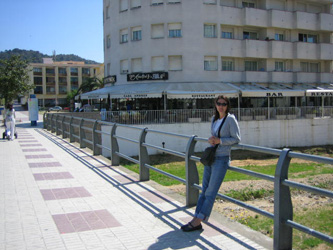
The street leaps over the river here.
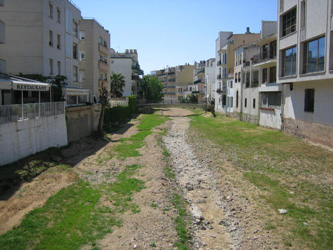
Tossa is a watershed for this area and the town straddles what can be a pretty fierce river when the storms hit. This spring is a dry one. The wet months are October and April. These people are big on their mushrooms and they will bum out bigtime if this Fall is another dry one.
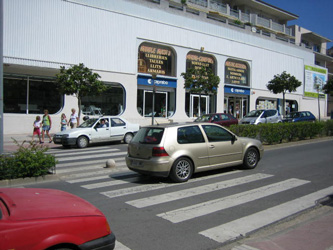
Ah, our destination is in sight. ?Caprabo!
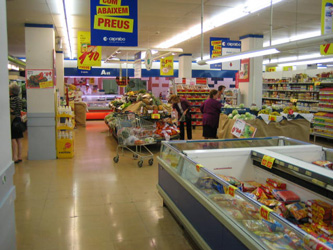
In Los Angeles, going to the store means jumping into the car. There, you buy food for an extended time. The food you buy has to handle the extend time intervals. Eating processed food fattens you up, so you have to drive to the gym to strenously work it off.
Here in the village, the refrigerator has a virtual treadmill in front of it. The food is fresher and the workout is natural. You meet friends along the way.
Notice the Catalan language signage, a seeming creole of French and Spanish (with apologies to my Catalan friends, Catalan is indeed a bonafide language and culture, this is true).

And the Spanairds are big on yogurt. I could go on, but I won't.
Suffice it to say that Dannon owns this place.

You've got to wiegh and price your own vegetables. There is not the variety that you would find in a 21st century speed of light megalopolis... shrug. One must learn to cook with what is available.

This day was a Sunday, so the fish counter is a little skinny.
On Fridays, this place is packed with people buying the weekend dinners. It's interesting to watch the lady behind the counter work, the tricks of the trade worthy of another blogpost of its own.

We haven't eaten the funny eel-like fish yet. There is another kind of fish that looks like spaghetti. It's sold here in small packages and people relish it as if it was pasta. I'm going to have go a little more native to do that.

The big mouthed one is called Rape (rah-peh). The body is very meaty. Its habitat is in the rocks under camouflage, angling virtual bait for its unwitting victims. Octopus (pulpos) are it's favorite meal.
We keep it pretty simple though. It'll take a few years living here to chow down on the catch of the day the way the locals do.
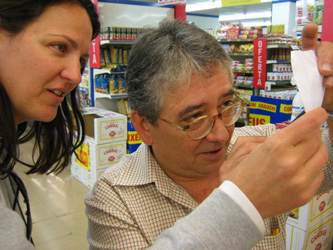
Usually as we shop Caprabo, we bump into Ramon, my carpenter. He likes to cook for his family, and he's always found prowling the aisles with a list in hand. A loving husband and father he is, a good man.
Trade secret: he doesn't like to use the cell phone, so I know that I can find him here or at the BusBar (dominos y una copa de vino with the fellas) after work.
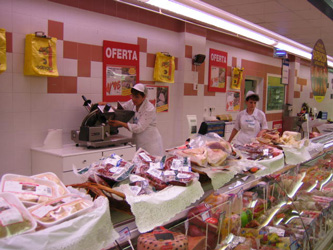
I wish I could make a photo essay on the way they handle meat here.
IT'S CRAZY! They're chopping and handling everything and meat's flying and they're touching bags and not washing hands and gutting chickens and mixing poultry with beef and pork and the hands that stuff the chicken tear off the reciept and tape it onto the bag with bits of flesh all over the bag... oh man, oh man. Talk about earthiness...
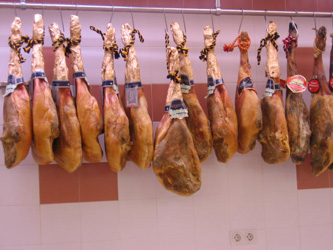
And ham is a big deal too. The very best is Iberico ham, made from wild boars who eat "only the acorns that drop from Spanish oaks"... they say the fat from such meat is healthier than the best olive oil. Stephanie converted back to meat after twenty years of vegetarianism, shortly before we arrived in Tossa last year. She loves the jamon iberico, loves it. De verdad.
I wonder if we can return with a big ol' boar leg through US customs?
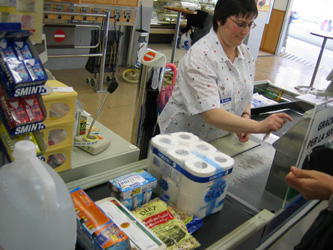
You have to bag your own.
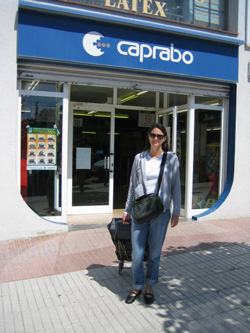
Mission accomplished.
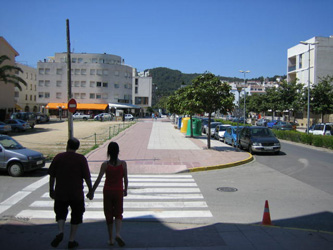
A view down the main street. This axis is along a coastal road from Lloret to the South to San Felieu to the North. Like big Sur, the road winds alot, very scenic.
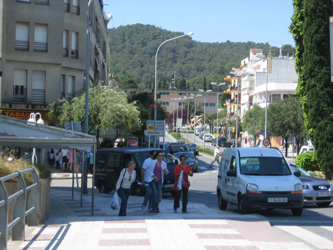
Telephoto up the street and you might be able to see the bus station, a hub of the pueblo.
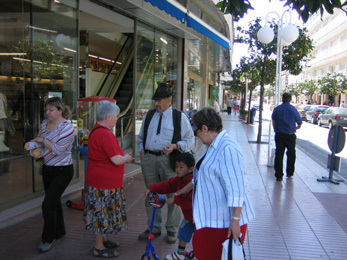
We'll take a left turn here into the main shopping street.
The higher priced grocery store, Palau, is on the left where the gentleman with the Barvarian hat is standing. A higher price point, but you can find exotic stuff like... peanut butter.

I like the "room" of the street, the containment of social space with nice proportions and a good brace of uses to eliven it.
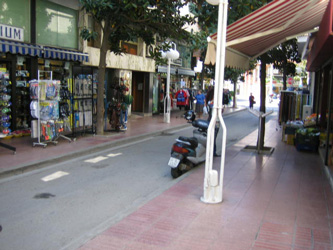
We'll take a right turn towards the Bar Savoy...

Here, one of the best bars in Tossa. The people are super real, smart, friendly, cool. The prices are fantastic, the food is very good for bar food. A few tables outside make for a nice way to pass the time and inside, the proportion of the interior space is excellent for hanging out with friends.
Muy bien, hombres. Mercedes, the owner, is wonderful and sweet.
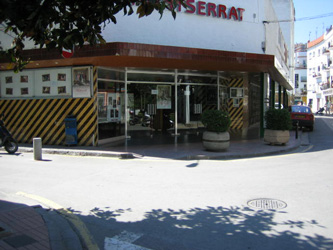
The theater interior is like something that time travelled from the sixties. It has a full bar inside. A cocktail with your movie, como no?
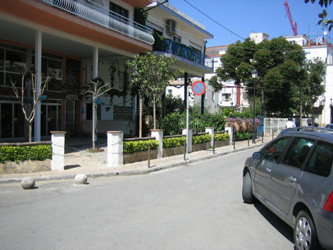
Pan to the right and check out how the big dogs are doing. An old Catalan guy is maintaining his finca and plot of land in the middle of town, in the ways of old. Three big dogs a fenced garden and a tiny grove of olive trees. He's keeping it real. They like to say: "We are simple people."
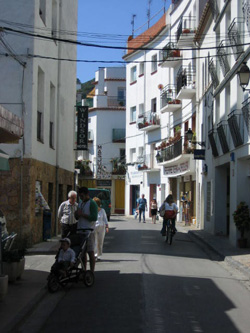
(Stephanie leans over and says: "Sixty pictures! Why not twenty?" But honey, how can we take a walk and not note the ferreteria -hardware store- where we buy our stuff?)
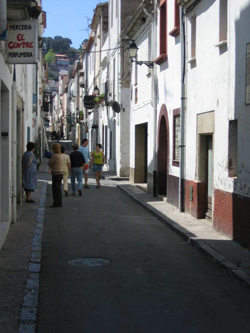
Continuing. This street cuts across town at a higher elevation. it's kid a cool street, full of odd shops.
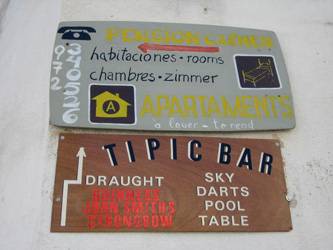
I had to shoot these handmade signs. Carmen owns a pension down the way. She's a lovable crone ( I write this affectionately) who is from somewhere South where people eat their vowels. She's the mayor of the street.
The Tipic Bar is owned by a guy who lived in California for most of his life (stories of gang life, a little prison time and long haul trucking) but is a Swiss citizen who was born in Mexico City. A colorful fellow. It will take a few beers at his bar to get the whole story.
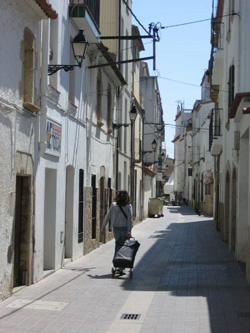
Resuming...
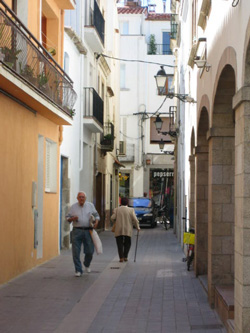
A right turn...

This littel curio holds court on the street in the window of this tourist shop. It's a funny ha-ha chester the molester toy a la Hustler Magazine style (with all the charm that implies). Crowds of toursits flock to the window to see him open his coat and flash is penis to the world.
Funny, maybe... but there's something wrong here. Maybe it's that such humor in a place like a bar is one thing, but to mainstream deviancy onto mainstreet is another. It makes me think of -what's his name? ... the guy who played the clown at kids birthday parties and later ate them?
Sometimes I think we shouldn't forget the tightrope that we choose to dance on... or lull the innocent into thinking that it's no big deal.
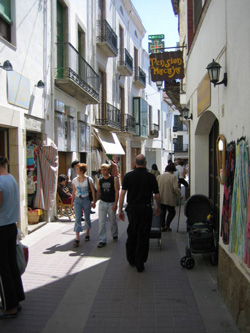
Keep it moving....
This street is another main pedestrian shopping street that bisects the town. It's packed with shops and restaurants.

I forget this guy's name, but he's very affable. He own's a micro shop, Cyclopea... which is supposed to evoke the sun and things to wear and enjoy the sun with. He hangs out in the street alot, a cool character.
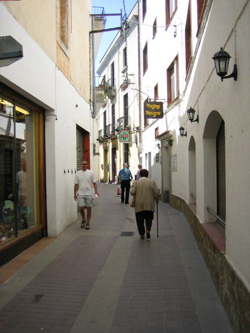
A right turn onto our street, Sant Telm.
Look, there's Willie!
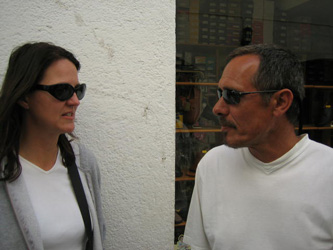
Willie is from Scotland. He's a retired firefighter. He's been painting his house that he's renting above Codolar Cove, a great place. Now, he tell us that he's thinking of getting a "...wee bit of work." I love the Scottish accent. I could listen to it all day long.
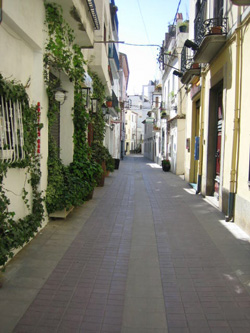
Resuming...

Stephanie has to stop into the Pharmacy. This one showcases its history.
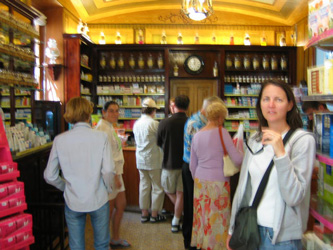
A blurred pic, but good for a flavor of the interior.
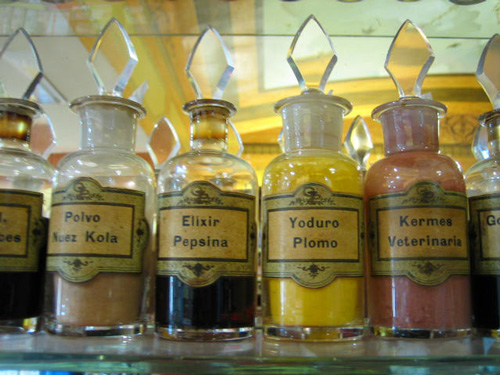
Elixir. I like that word.

This place is for sale, people. Come on, my Angelino friends, this is a hot property! A former restaurant, I don't know how big it is inside. Very rustic. And close to the beach. Think about it, fellow Californians: for most of us, buying a house near the beach in California is out of the question, especially one so ancient. Let's be neighbors!
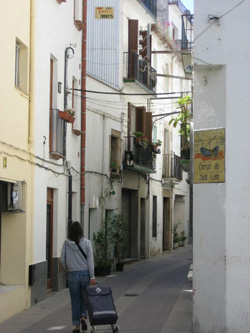
Keep it moving, we've got groceries in the cart.
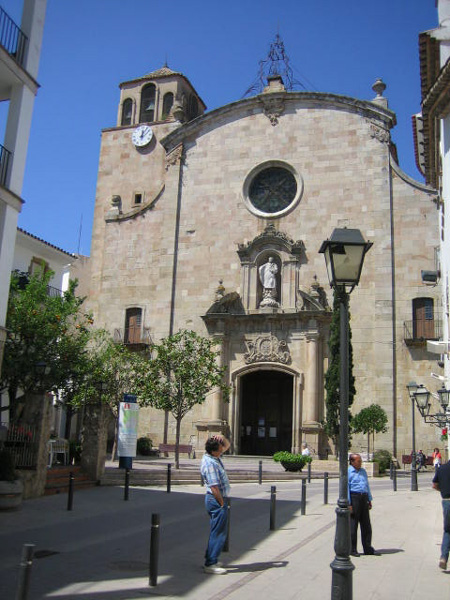
Vaya con Dios.
You can see the bullet holes from the Civil War on the fascade.
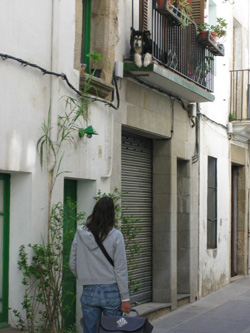
Keep it moving.
(Check out the dog on the balcony. I think the poor thing is deaf.)
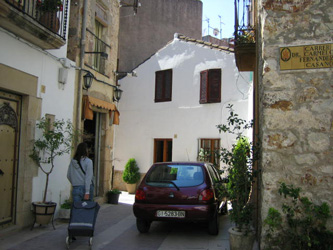
Victoria's home is muy guay, very cool. I'll have to blog her place one day. It's like a ship captain's cabin: small, tightly put together and very efficient.
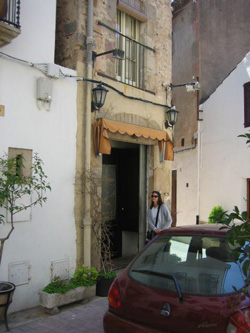
Home at last.
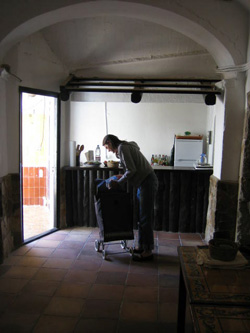
May 12, 2005
"seriousness"-brown

In the same way a writer must possess a "voice", an artist (painter) will know that they are hunting big game when they finally possess their own vision, a "voice" in painterly terms. After much labor in the effort to enlarge that personal vision, or what may be called a signature style, the time comes for a personal revolution. A static vision goes blind eventually.
Change in this case is not only good, it's required. Change is also dangerous. If the change is flagrant, the voice is gone and the artist is lost... for the whole world to witness, sadly enough. But when an artist makes a turn that not only plows new ground but also hauls the older project along for the transformative ride... this is simply marvelous.
Michael Reafsnyder has done it. A turn to marvel at.
Here is one of his paintings, a point of reference:
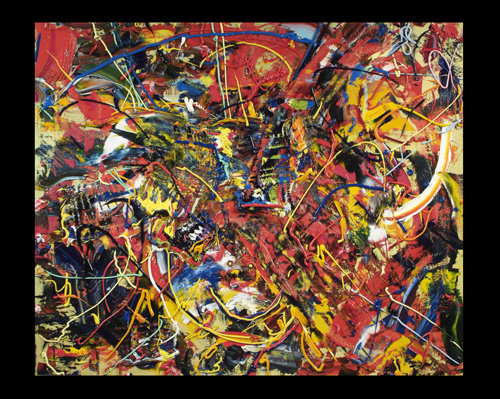
Bronze, I am not sure why other than to say I think it had to do with what my paintings would look like in the language of "seriousness"-brown. Funny enough, the few who have seen them bring up the serious term and how they force people who refuse to take my paintings as something other than ironic, sarcastic, etc. to look again. I do not do the work myself. I found a great place called F & M in Buena Park. Fantastic work and inexpensive. Much cheaper than the few "art" foundries in Los Angeles. These guys think I am crazy, but, are very sensitive and attentive to my lack of knowledge and desires. The ceramics initially came prior to the bronze work, although I am still working on them now. First I made figurines, trying to make the painting characters 3-D. They are quite nuts, mermaids and all. The plates came as a natural progression, or regression, and I think really force paint and all of its tricks to move the the forefront and not act as addition, but accumulation and subtraction. Dimensionality was difficult to achieve, but, I have finally figured it out.
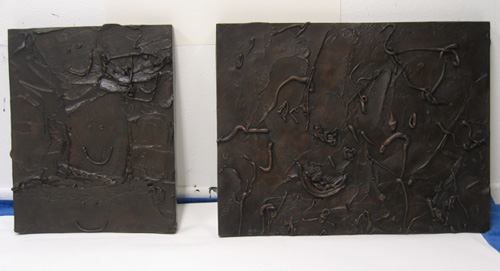
What I like about this is that compared to, say, the great David Reed and his video/installation turn, Michael Reafsnyder has folded one legacy media form into another legacy media form. That's much better (after David Reed has popped his wheely thusly) than a computer-plus-flat screen TV gig or somesuch next generation media geegaw*.
Brilliant, Miichael.
You can see Michael's new work at Los Angeles' Chinatown's Black Dragon Society, 916 Chung King Road.
* ...like this here blog, Dennis?
Ixtlan
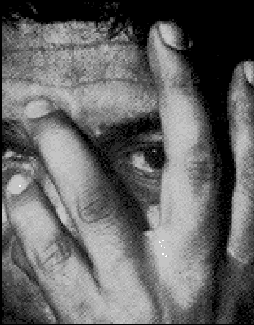
"What happened when you grabbed your ally, don Genaro?" I asked.
"It was a powerful jolt," don Genaro said after a moment's hesitation. He seemed to have been putting his thoughts in order.
"Never would I have imagined it was going to be like that," he went on. "It was something, something, something ... like nothing I can tell. After I grabbed it we began to spin. The ally made me twirl, but I didn't let go. We spun through the air with such speed and force that I couldn't see any more. Everything was foggy. The spinning went on, and on, and on. Suddenly I felt that I was standing on the ground again. I looked at myself. The ally had not killed me. I was in one piece. I was myself! I knew then that I had succeeded. At long last I had an ally. I jumped up and down with delight. What a feeling! What a feeling it was!
"Then I looked around to find out where I was. The surroundings were unknown to me. I thought that the ally must have taken me through the air and dumped me somewhere very far from the place where we started to spin. I oriented myself. I thought that my home must be towards the east, so I began to walk in that direction. It was still early. The encounter with the ally had not taken too long. Very soon I found a trail and then I saw a bunch of men and women coming towards me. They were Indians. I thought they were Mazatec Indians. They surrounded me and asked me where I was going. 'I'm going home to Ixtlan,' I said to them. 'Are you lost?' someone asked. 'I am,' I said. 'Why?' 'Because lxtlan is not that way. Ixtlan is in the opposite direction. We ourselves are going there,' someone else said. 'Join us!' they all said. 'We have food!'"
Don Genaro stopped talking and looked at me as if he were waiting for me to ask a question.
"Well, what happened?" I asked. "Did you join them?"
"No.I didn't," he said. "Because they were not real. I knew it right away, the minute they came to me. There was something in their voices, in their friendliness that gave them away, especially when they asked me to join them. So I ran away. They called me and begged me to come back. Their pleas became haunting, but I kept on running away from them."
"Who were they?" I asked.
"People," don Genaro replied cuttingly. "Except that they were not real."
"They were like apparitions," don Juan explained. "Like phantoms."
"After walking a while," don Genaro went on, "I became more confident. I knew that IxtIan was in the direction I was going. And then I saw two men coming down the trail towards me. They also seemed to be Mazatec Indians. They had a donkey loaded with firewood.. They went by me and mumbled, 'Good afternoon.'
"'Good afternoon!' I said and kept on walking." They did not pay any attention to me and went their way. I slowed down my gait and casually turned around to look at them. They were walking away unconcerned with me. They seemed to be real. I ran after them and yelled, 'Wait, wait!'
"They held their donkey and stood on either side of the animal, as if they were protecting the load.
"'I am lost in these mountains,' I said to them. 'Which way is Ixtlan?' They pointed in the direction they were going. 'You're very far,' one of them said. 'It is on the other side of those mountains. It'll take you four or five days to get there.' Then they turned around and kept on walking. I felt that those were real Indians and I begged them to let me join them.
"We walked together for a while and then one of them got his bundle of food and offered me some. I froze on the spot. There was something terribly strange in the way he offered me his food. My body felt frightened, so I jumped back and began to run away. They both said that I would die in the mountains if I did not go with them and tried to coax me to join them. Their pleas were also very haunting, but I ran away from them with all my might.
"I kept on walking. I knew then that I was on the right way to IxtIan and that those phantoms were trying to lure me out of my way.
"I encountered eight of them; they must have known that my determination was unshakable. They stood by the road and looked at me with pleading eyes. Most of them even displayed food and other goods that they were supposed to be selling, like innocent merchants by the side of the road. I did not stop nor did I look at them.
"By late afternoon I came to a valley that I seemed to recognize. It was somehow familiar. I thought I had been there before, but if that was so I was actually south of lxtlan. I began to look for landmarks to properly orient myself and correct my route when I saw a little Indian boy tending some goats. He was perhaps seven years old and was dressed the way I had been when I was his age. In fact, he reminded me of myself tending my father's two goats.
"I watched him for some time; the boy was talking to himself, the same way I used to, then he would talk to his goats. From what I knew about tending goats he was really good at it. He was thorough and careful. He didn't pamper his goats, but he wasn't cruel to them either.
"I decided to call him. When I talked to him in a loud voice he jumped up and ran away to a ledge and peeked at me from behind some rocks. He seemed to be ready to run for his life. I liked him, He seemed to be afraid and yet he still found time to herd his goats out of my sight.
"I talked to him for a long time; I said that I was lost and that I did not know my way to Ixtlan. I asked the name of the place where we were and he said it was the place I had thought it was. That made me very happy. I realized I was no longer lost and pondered on the power that my ally had in order to transport my whole body that far in less time than it takes to bat an eyelash.
"I thanked the boy and began to walk away. He casually came out of his hiding place and herded his goats into an almost unnoticeable trail. The trail seemed to lead down into the valley. I called the boy and he did not run away. I walked towards him and he jumped into the bushes when I came too close. I commended him on being so cautious and began to ask him some questions.
"'Where does this trail lead?' I asked. 'Down,' he said. 'Where do you live?' 'Down there,' 'Are there lots of houses down there?' 'No, just one.' 'Where are the other houses?' The boy pointed towards the other side of the valley with indifference, the way boys his age do. Then he began to go down the trail with his goats.
"'Wait,' I said to the boy. 'I'm very tired and hungry. Take me to your folks.'
"'I have no folks,' the little boy said and that jolted me. I don't know why but his voice made me hesitate. The boy, noticing my hesitation, stopped and turned to me. 'There's nobody at my house,' he said. 'My uncle is gone and his wife went to the fields. There is plenty of food. Plenty. Come with me.'
"I almost felt sad. The boy was also a phantom. The tone of his voice and his eagerness had betrayed him. The phantoms were out there to get me but I wasn't afraid. I was still numb from my encounter with the ally. I wanted to get mad at the ally or at the phantoms but somehow I couldn't get angry like I used to, so I gave up trying. Then I wanted to get sad, because I had liked that little boy, but I couldn't, so I gave up on that too.
"Suddenly I realized that I had an ally and that there was nothing that the phantoms could do to me. I followed the boy down the trail. Other phantoms lurched out swiftly and tried to make me trip over the precipices, but my will was stronger than they were. They must have sensed that, because they stopped pestering me. After a while they simply stood by my path; from time to time some of them would leap towards me but I stopped them with my will. And then they quit bothering me altogether ."
Don Genaro remained quiet for a long time.
Don Juan looked at me.
"What happened after that, don Genaro?" I asked.
"I kept on walking," he said factually.
It seemed that he had finished his tale and there was nothing he wanted to add.
I asked him why was the fact that they offered him food a clue to their being phantoms.
He did not answer. I probed further and asked whether it was a custom among Mazatec Indians to deny that they had any food, or to be heavily concerned with matters of food.
He said that the tone of their voices, their eagerness to lure him out, and the manner in which the phantoms talked about food were the clues--and that he knew that because his ally was helping him. He asserted that by himself alone he would have never noticed those peculiarities.
"Were those phantoms allies, don Genaro?" I asked.
"No. They were people."
"People? But you said they were phantoms."
"I said that they were no longer real. After my encounter with the ally nothing was real any more.".
We were quiet for a long time.
"What was the final outcome of that experience, don Genaro?" 1 asked.
"Final outcome?"
"I mean, when and how did you finally reach Ixtlan?"
Both of them broke into laughter at once.
"So that's the final outcome for you," don Juan remarked. "Let's put it this way then. There was no final outcome to Genaro's journey. There will never be any final outcome. Genaro is still on his way to Ixtlan!"
Don Genaro glanced at me with piercing eyes and then turned his head to look into the distance, towards the south.
"I will never reach Ixtlan," he said.
His voice was firm but soft, almost a murmur.
"Yet in my feelings ... in my feelings sometimes I think I'm just one step from reaching it. Yet I never will. In my journey I don't even find the familiar landmarks I used to know. Nothing is any longer the same."
Don Juan and don Genaro looked at each other. There was something so sad about their look.
"In my journey to Ixtlan I find only phantom travelers," he said softly.
May 11, 2005
Logistics Barcelona
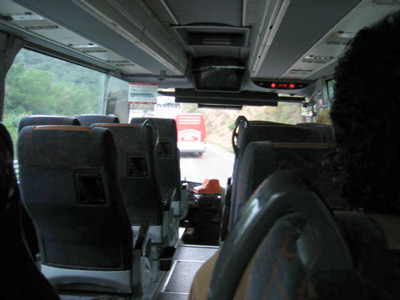
Living this auto-free life is wonderful. But there are days when the supply chain breaks down and you have to schlep around and get some of the important logistical stuff done.
My art supplier, an online company based in Brussels by the name of Schlieper, has been the key in living and working in a relatively remote village such as Tossa de Mar. In the beginning, the elapsed time between a click of the mouse and a knock by the deliveryperson at the door was about two weeks. Recently, it has taken over a month...
Not Good.
So, yesterday, we took the Sarfa bus to Barcelona to do a little shopping.
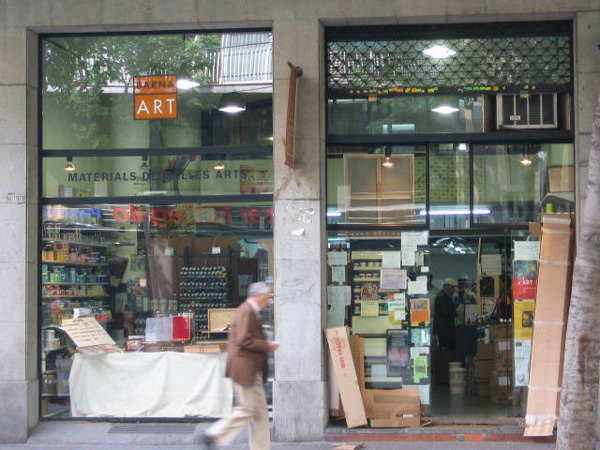
Barna Art is the art supply store in Barcelona. A little old and frayed, it has nearly everything you need from custom stretched canvas to printing ink. On this day, there was a steady stream of people at the cash register. Prices are a little high though... by about 20 percent higher than I have been accustomed to. Add to this, about 32 percent more for the battered dollar, banking fees coming and going, top it off with a bus ticket, and you have a slightly tarnished shopping experience.
Oh well.
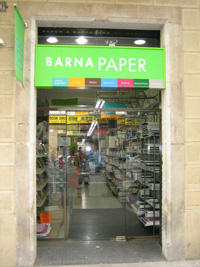
If you are visiting Barna, don't forget to visit Barna Paper, which is a block away. Good stuff.
Stephanie shopped Zara and Miss Sixty at the Passeo de Gracia. We ate Basque tapas to sooth the strain on the bank accounts.
A good day but a day not in the studio though.
May 8, 2005
Ahora
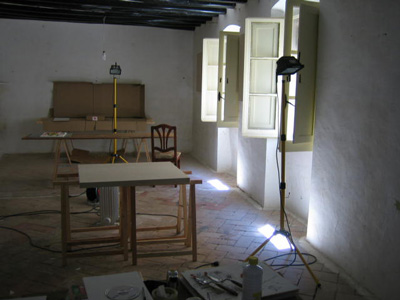
Our very important visitors were Miguel Marcos and his wife, Maria Mirentxu. Galleria Miguel Marcos is near the Plaza Cataluy?a, on the same block as that of a famous theater that I should know more about. (Ahem. Research pending.) Andr? made the introductions and we're glad he did becasue Miguel and Maria are delightful to be with. We met at their gallery a month ago and had dinner by the wharfs on a sunny Sunday afternoon.
Miguel is always up to something in conversation. And to raise the linguistic bar, he invents words, his own private vocabulary. Sporting a squinting eye and a lance in play such as:
"I'm going to ask you a question, and it's ok if you don't want to answer it but I'm going to ask you a question and I want you to tell me the truth."
That time, the question was "...why painting?". My answer -by my critique- was miserable. Awful. Muddled. Confused. Rambling. Yesterday, his question was aimed at the waiter: "...is the paella of this restaurant good?".
I felt a little better.
I enjoyed the studio visit, and it was great to have them here. Mirentxu is a lawyer and a judge and a teacher at the university in Barcelona. She's muy simpatico and she was polite to tolerate the frequent translations. Miguel asked me to join a group show (peeps like Schnabel, Barcelo, Pistoletto?) with a couple of paintings this June and of course I said yes. I'll post an announcement as soon as possible.
Spinning plates here, people. Say yes to life. Do it all. Life's short.
All the while, I've been thinking of moving wet rags over wet fields and attempting what I did before on canvas, now over a wet ground. Going from side to side, pinging off the edges over the whole visual field. Finally, the first touch demolishes all of the empires built in my minds eye... if I'm lucky.
May 7, 2005
Guess?


Something's happening... good things.
The short story:
Stephanie has just returned from a four day trip to Los Angeles where she accepted an offer to work for Guess? as design director of Young Contemporary! It's a bit of a story to tell, Stephanie's journey as a designer in the fashion industry. It's natural to her as breathing and she takes on the ardous tasks as adirector of design with elan. Returning to the company wil be a homecoming and all of them are saying that she's the missing link. It's fantastic that she will be working with a good team.
Of course the company can't wait until after our summer here in Tossa, so Stephanie will have to return to LA before me. I'll stay and paint for the show in Haarlem, to return to LA shortly after the opening in the end of August/beginning of September. Stephanie will return to Tossa twice this summer, once in the middle and another at the end when we travel to the Netherlands for the show.
The hermit gene in me stirs. Hmmmmmmmmmmmm. Months solo here in Tossa. I'll get to do a Howard Hughes, long fingernails and strange hair! Yea.
Please remember: we aren't leaving Tossa, we are simply going... to LA. We will be back, to both places.
May 6, 2005
Well Enough Alone
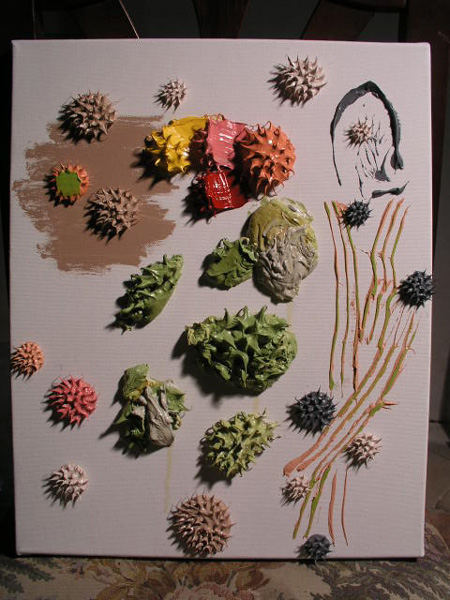
Remember this?
(I guess I couldn't leave well enough alone.)
May 3, 2005
Transcendent
Rock music was transcendent, Landau believed, because it was primitive, not because it could be avant-garde.
Scott Barber
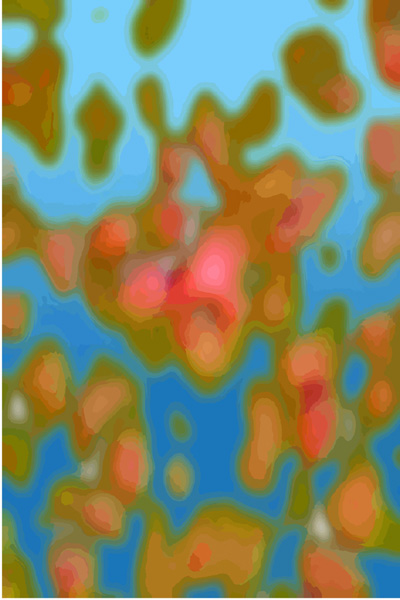
Dennis, perhaps you have heard of Scott Barber's death. His service was yesterday at St. Mark's School Chapel, standing room only. It was way too soon for him. He survived the really tough part of the stem cell transplant and picked up an infection in the hospital that he could not overcome. Really sad. Best, Pamela
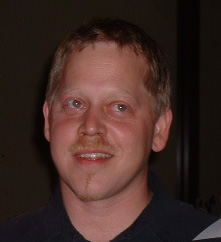
May 2, 2005
remoteness beyond
With Lat?co?re, Saint-Ex flew some of the most hazardous early mail routes over the Mediterranean, the Sahara and the Andes. During these years, he encountered the two elemental trinities - "wind, sand and stars", "mountain, sea and storm" - which he would worship for the rest of his life. And he came to understand that he was a man who found himself by getting lost. Flying, radioless, with limited fuel, above desert or ocean expanses, was his preferred state. He felt most at home in "a remoteness beyond possibility of homecoming".
Goldfish Holiday
PressPruessPress
A message to Rabbi Milkblood: It's alright.
Andres Butzer
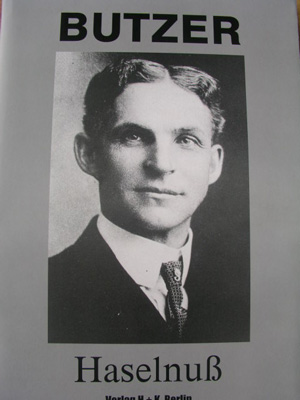
This is one artist that I didn't meet in Berlin, but he is one whose name dropped constantly in conversation. I'm having trouble finding images of his work online (I'll update this post when I find a better image), but here is a shot taken in the gallery storage room:
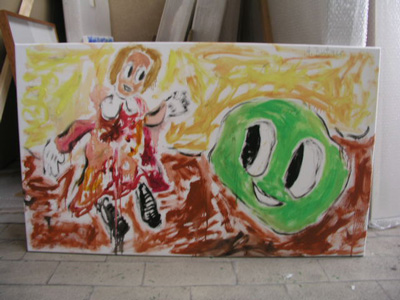
O: I used to call my pictures "post-non-representational painting," and later "Procrustean painting." The first term was supposed to express that I wanted to get these problems out of the way. With the second term I reject all ethics of painting. "Procrustean" stands for bending, breaking, stretching, cropping. Not very careful of the material.
B: You must mean more than just the material. Namely also the alleged expression of a person, an expression that you can never get rid of (or abolish). Of course, it depends on what you apply the term "material" to in painting.
O: For me, putting paint on the canvas is like driving an unfamiliar vehicle or a rental car you just do it.
B: And for me, applying paint is cosmetics on the decline and fall of humanity.
O: So, that's supposed to mean that people can smear your paintings onto their legs(or: you don't care a shit what humanity thinks of your paintings). Sort of a "kiss-my-ass" attitude. But listen, with that you won?t get very far! Sometime you?ll want to come back into the human community, because of its warmth.
Because of its warmth?
This exchange is a beast, dense, obtuse, tough to read, flagrant with flights of fancy, hard work and rough on the eyesight with the font-color selection and website design. I wonder how people can actually talk like this. (Lemme try: "I'm typing this blogpost like dragons have breathed flaming ice on my family..." Uh-huh.)
But I've copied it onto a sticky note and I'm carving away chunks, looking for gold. I'll keep you posted if I find any.
Note that he is talking with Albert Ohlen, a painter whose program is deliberate bad painting. Here we go again.
Check it out.
PS: That's not Butzer on the cover of the catalog. It's Henry Ford and I've heard that he looks a llittle like the great industrialist.
Dan Hug
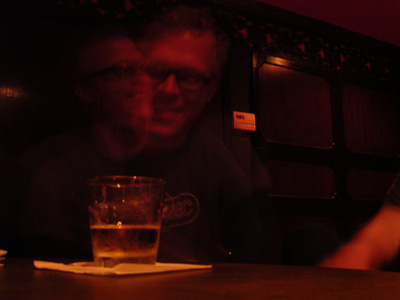
During this whole visit to Berlin, thoughts of Dan Hug surfaced repeatedly. Dan represents several Berlin artists such as Thomas Zipp and his wife Hanna-Maria Blenke, and Thomas Winkler too.
Dan operates a gallery in Chinatown LA, before that he was located on the corner of Wilshire and Fairfax, then sporting the name "Chicago Project Room". He anticipated the current flow of artists from Chicago to LA by several years.
But it has to be said (hence this particular post) that Dan anticipated this resurgence of NeoExpressionism, a Neo-NeoExpressionism if you will. Going from Jorge Pardo's slick but bland Ikea-Internationalist agenda to the street fighting level of Thomas and Galerie Guido W. Bandach's stable... it seems that there is a revolt against the suave and sophisticated underway... much like the turn of events at the end of the seventies that fueled the TransVanguardia.
And Dan was on it loooooong before anyone else. Talking to him (years ago) about it, I remember being amazed at his depth of knowledge of this young German generation. Dan knows his stuff, and the world should know that he does.
I found images of the work of Thomas' wife Hanah-Marie Blenke:
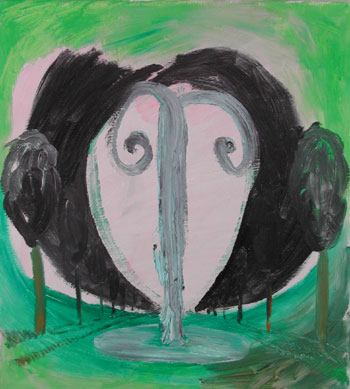
She was driving us back from dinner one night, and we talked of painting as she attacked the roadway like an Angeleno. She mentioned good painting and I asked her what that was for her. She said: "Strong, direct and honest.", and she said it strongly, directly and honestly.
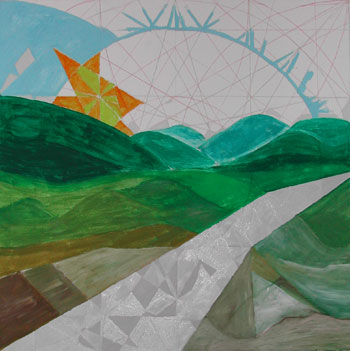
***
I'm thinking too, of the perfect storm of representational/ neoexpressioinist painting in LA. Consider these forces:
-the recent diaspora of Chicago artists for LA and other places (Berlin) Chicago has a solid reputation fo representational art
-the seeming exhaustion of the current post-everything international art fair art
-the tutelage of Roger Herman in UCLA and the formatioin of the Black Dragon Society in Chinatown
-the historical swelling of art schools, every year churning out thousands of artists steeped in fashion/teen angst and the kind of art one makes in a teenager's bedroom
-the extinction of theory and the dearth of new sprouts of art-philosophical dialog in the press at large
Just a thought. More than this, it is an argument coming from certain young artists in LA. What do you think?
Galerie Guido W. Bandach

A short walk from Thomas' studio, Galerie Guido W. Bandach represents his work.
What a space, huh?
What is particularly good is the low cost use of materials, stretched towards the limit in outfitting a white cube: Particle board stacked in a brick pattern, painted white; the windows overlain with a sheet of plastic sheeting, slung over a wood grid, and the floors skinned with rolled linoleum sheets.
And now, the back room:
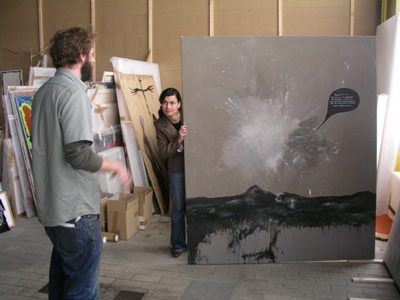
Here is a Thomas Zipp landscape. We learned that Thomas likes to work in certain modes (landscape being one), he encrypts his work with codes and hidden messages, that he uses irony and he addresses work to the sites in which the work is shown. For example, in a show in England, he adorns figures with cartoon bubbles that say "F__k England; or in other examples, he will abstract a bomb aloft over a landscape and encrypted words will indicate which cities should recieve a bombing. Now, we are assured by the gallerist (and by Thomas in his mild manner) that an ironic twist will divert any apparent aggression toward the (seemingly) benign needs of art to be provocative.
Another example: I left before May Day, but Joel and Phil had plans through the weekend. We recieved many invitations to attend the "celebrations" (from a safe distance, I assume). The general attitude was that on that day, the leftists gather in the streets to let off some anti-establishment steam. They burn cars and take up the cobblestones and break the windows. (I hope your alarms are going off in your head as mine did.) "It's no big deal.", they said, "They like to put up a show, it means nothing." We were told that even the police get into the act by dressing in black polished leather and sporting mohawks beneath their helmets.
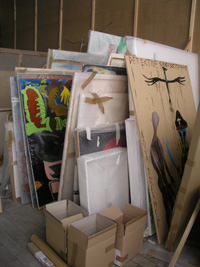
Thomas Zipp
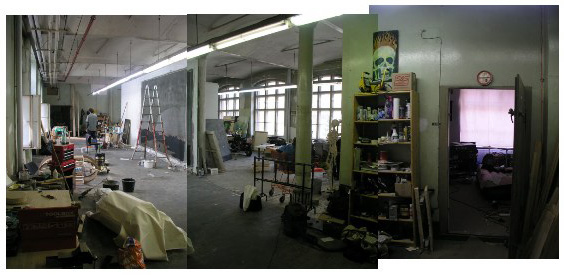
Strap on your set belts for a massive post on a Thomas Zipp studio visit. I've got fourteen plus pics ready to rock...
Thomas Zipp, what a great guy! Joel met both Thomas Zipp and Thomas Winkler via Daniel Hug in Chinatown. Eventually, they got together to make music and print projects. Muy bien, hombres.
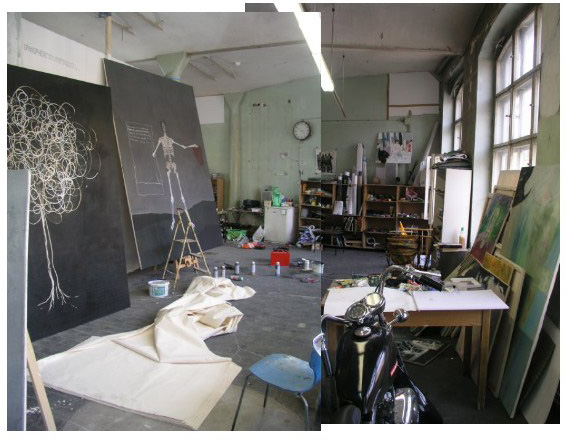
Thomas' studio is located in a huge complex that is so large, it has it's own police sub station. Fortunately, Thomas is one of the few artists there, and there is only one gallery (I will post something on it later), one that happens to represent Thomas Zipp too.
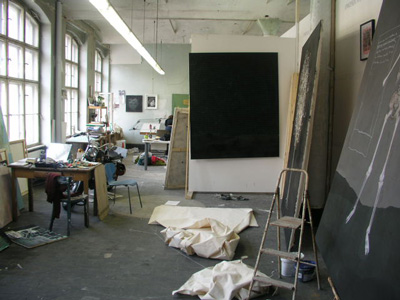
I've heard that Thomas has been compared to Anselm Kiefer, the next generation. I would guess that this is so because of a focus on the nature of German character. This, apparently a question that has become urgent in Germany in the aftermath of the highjinks of the 20th century.
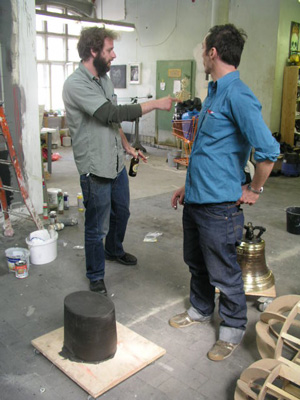
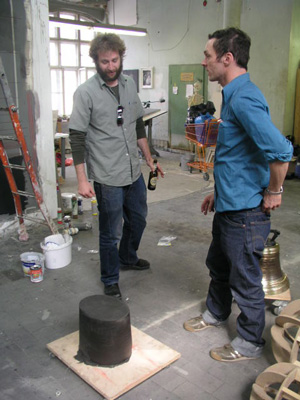
Looking at all of these large thin stretched canvases, I ponder the significance of my heavy furniture-like supports. Supports such as we see here in this studio point in the direction of big surface installations, environments of art, painting into installation.
My stuff in terms of how art occupies/defines space, seems to point the other way.
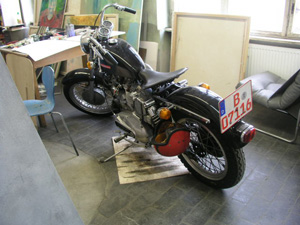
Thomas seems at first glance to be quite a roughneck. Witness the Harley, for example. A fine bike. And check this out:
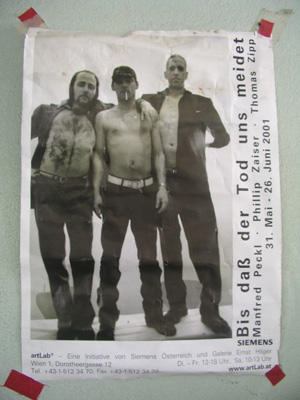
He might seem like a real head banger. And he might well be, but I found Thomas Zipp to be a generous, open, curious and honest guy. A very fine fellow he is, and I look forward to seeing him again.
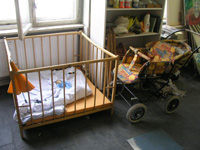
Baby on board.
His wife and the mother of his daughter is painter Hannah-Marie Blenke (I'll post images in an upcoming post on Dan Hug).

Thomas had this bell fabricated in Poland, where there is a good foundry there. The foundary didn't make bells before, so Thomas had to research the proper cross section for it. From drawings, the Poles crafted a positve form from clay, then they fashioned a mold from clay and poured the brass/bronze.
The inscription: "spirit without body".
We thought it might be a good idea to hang it up and ring away...
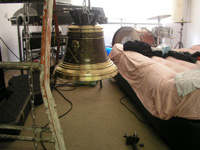
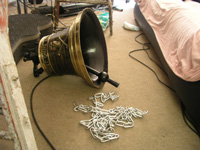
The bell was too heavy. It busted a link in the fall, a close call.
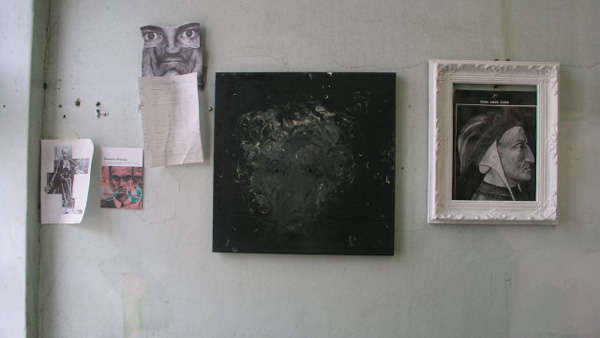
Then, I was looking at the work and the life of this artist, and the thought of mapmaking came to mind. I said to Thomas: "You're a cartographer!". Joel and Thomas both shifted uncomfortably in place, shrugging.
Joel is all into figural expressionism. When he paints, that's the stuff he does. Most of the paintings he champions is of that sort. And Thomas seems to be committed to some kind of directed force. The overtones of Levis, leather, Harley steel, flaming skulls... all indicate energy, male energy. A cartographer seemed to strike them as a nebbish sort perhaps. Maybe I was harshing their wild high. But I respect their vision, make no mistake... and I find it inspiring and energizing.
So I pointed to the evidence: the lines, the landscapes, the skeletons (which are armatures for the body, calcium lines* if you will), and the bells (a navigator with charts and compasses and sextants and bells)...
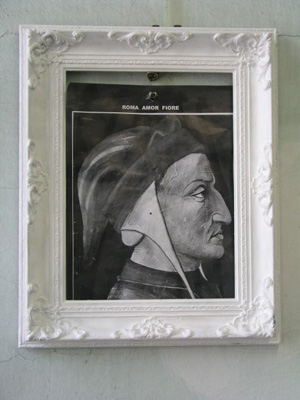
And there is Dante on the wall! Dante, who mapped hell in the Inferno. Another historical personage he paints portraits of is Tycho Brahe, who mapped the heavens (selected over Gallileo probably because he proposed an alternative cosmography).
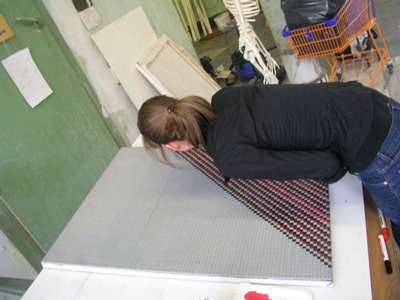
And here the assistant is hunched over a painting in the same way I used to work when I was the chart petty officer back in the navy days. Markers, grids.
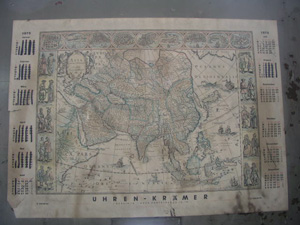
And look! Here, a ye olde map on the wall!
Then Thomas said: "It was there when I got the studio."
Oh.
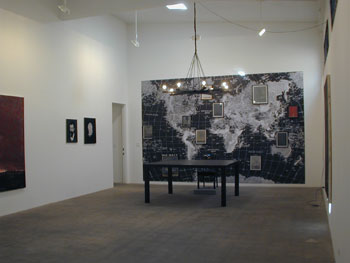
Later, googling to Dan Hug's website, I find this installation shot.
A new kind of cartographer with a beer choked at the neck and a glock in the waistband.
I rest my case.
* This makes me think of the body as painting. In the former as in the latter, drawings (lines as skeletons) and paint (fluidity as flesh)... the coordinates match perfectly. This, painting as the interaction and dance between lines that cut distinctions and paint that oozes and flows across all boundaries.
Professor Winkler
.jpg)
One of the artists I met on the Berlin visit was thomas Winkler, aka Professor Winkler. A very funny guy, un caballero muy simpatico. He's from Southern Germany (Stuttgart?) where he says the accent sounds funny to other Germans. I understand that he is more of a performer, a writer. He likes to give speeches.
I found this image at this site, of which I know little about (it looks interesting, I'll find the main page and check it out). I'm looking forward to seeing more of Thomas' work. Judging by our conversations, he seems to be very good. This site also refers to Daniel Hug, aka Chicago Project Room, of which I shall subject a post later. Stay tuned!
Also, don't miss this great song written by the Professor on a drive from Las Vegas to LA.
Muy bien.
The Mechanic

Phil was in town to install another Jorge Pardo show. He's part of the crack team behind the Pardo enterprise. Here, Phil and the gallery staff at Neugeriemschneider Gallery are wrangling with the installation of a show involving lamps, a table with an integrated Apple computer, a "grandfather" clock (animated by another Mac Mini), and paintings, so I've heard.
Phil is the mechanic, like Winston Wolf. Remember the Tarantino film?
The Wolf: You're... Jimmie, right? This is your house?
Jimmie: Sure is.
The Wolf: I'm Winston Wolf. I solve problems.
Jimmie: Good, we got one.
The Wolf: So I heard. May I come in?
Jimmie: Uh, yeah, please do.
Oh yea, and the balloons? The young lad Daniel (an artist from Texas who works for the gallery) has a special technique for hanging lamps.
Berlin

What a great time I've had in Berlin! Five days of friends, deep art talk, endless beers (Berliners), high jinks, multiple art vector rendezvous, sleeping on the floors of friends' places, studio visits...
All this and no gallery/museum hopping, no tourist checklists, none of that. Berlin is too big and diverse to take in in one trip alone. The unspoken rule was to keep it real, curiosity driven, and driven by art. Usually, we would start a day walking towards Strasse des 17 Juni, crossing the Spree River and inevitably we would veer back (wearying too soon of the forced march of tourism) to the neighborhood centered around the intersection of Friederichstrasse, Chausseestrasse, Torstrasse and Oranienburgerstrasse; this, where the pull of street cafes (great street food, Turkish d?ners for example, and prices are reasonable) and the amiable streets proved to be irresistable.
I'll be back, for sure. "Berlin is New York in the seventies." Property is accessible, reasonably priced (studio rent is pretty low, art people!), the population (at least in this neighborhood) is diverse and anchored by a happy middle class, publc transportation is ample, clean and fast, and the scruffy edge. How can I explain here how I find graffitti, trash, abandoned lots, and dilapidated buildings reassuring? In short, because the vector of gentrification is present but not yet active and such places present a possibility for the imagination, unlke what I've seen in Southern France for example, where life is so perfect and ordered that I can't imagine carving out a living space of my own within it.
A message to all my young artist friends: get your butts over to Berlin post haste.
I've got a load of blog posts for you and pardon me while I spit into my hands and chop some wood for a while. I've got to get this stuff out and get myself into the studio. Here we go....

